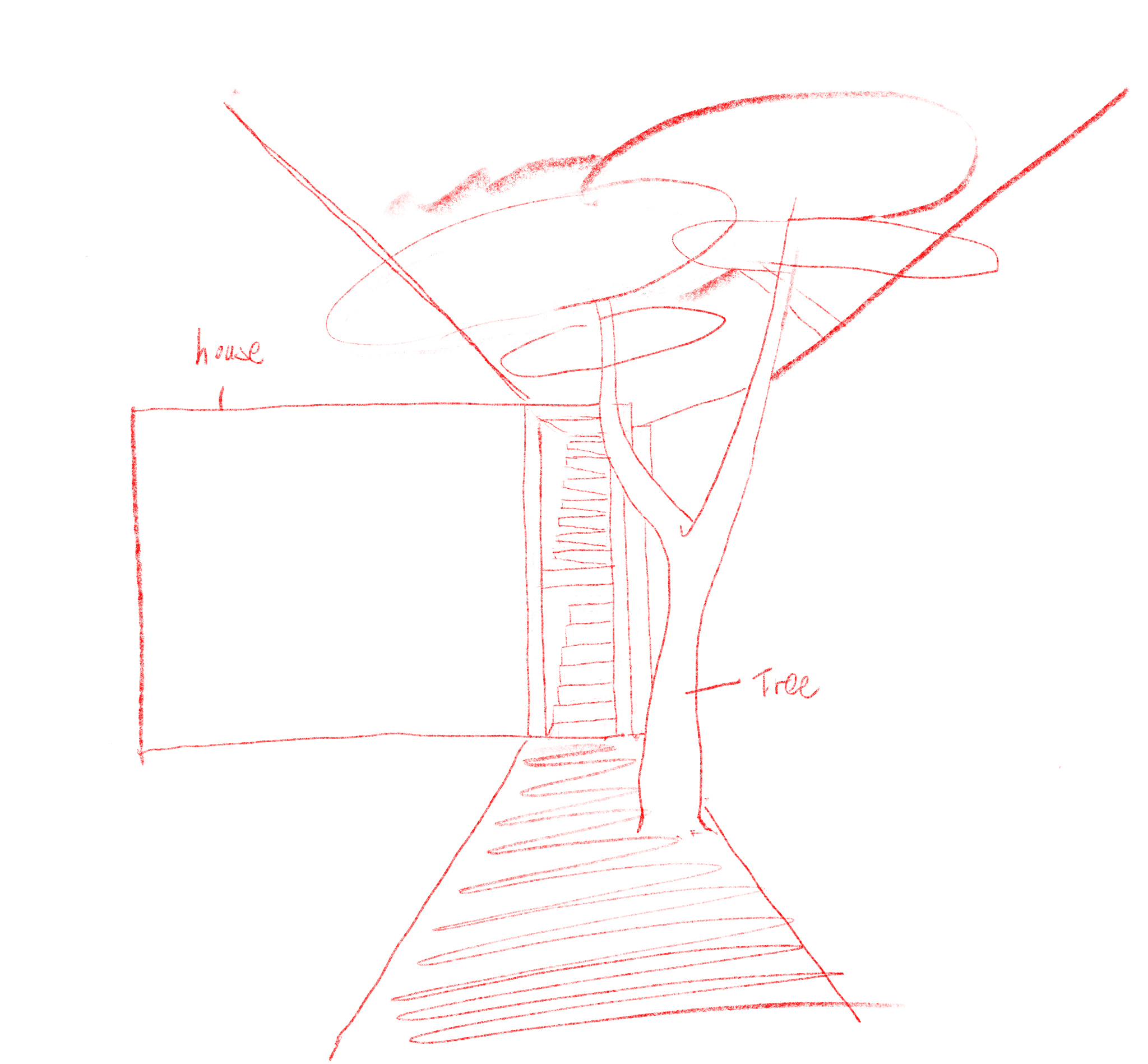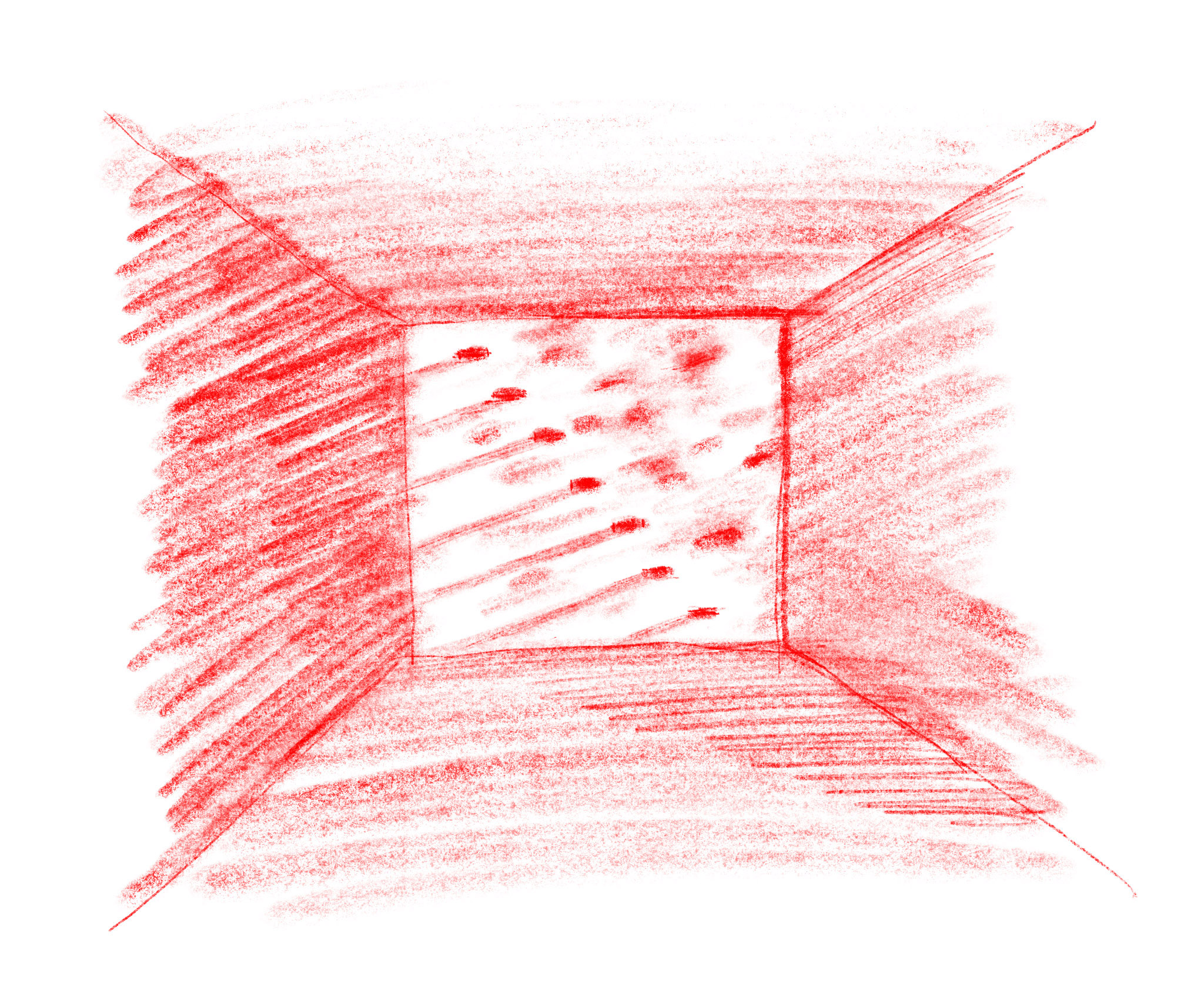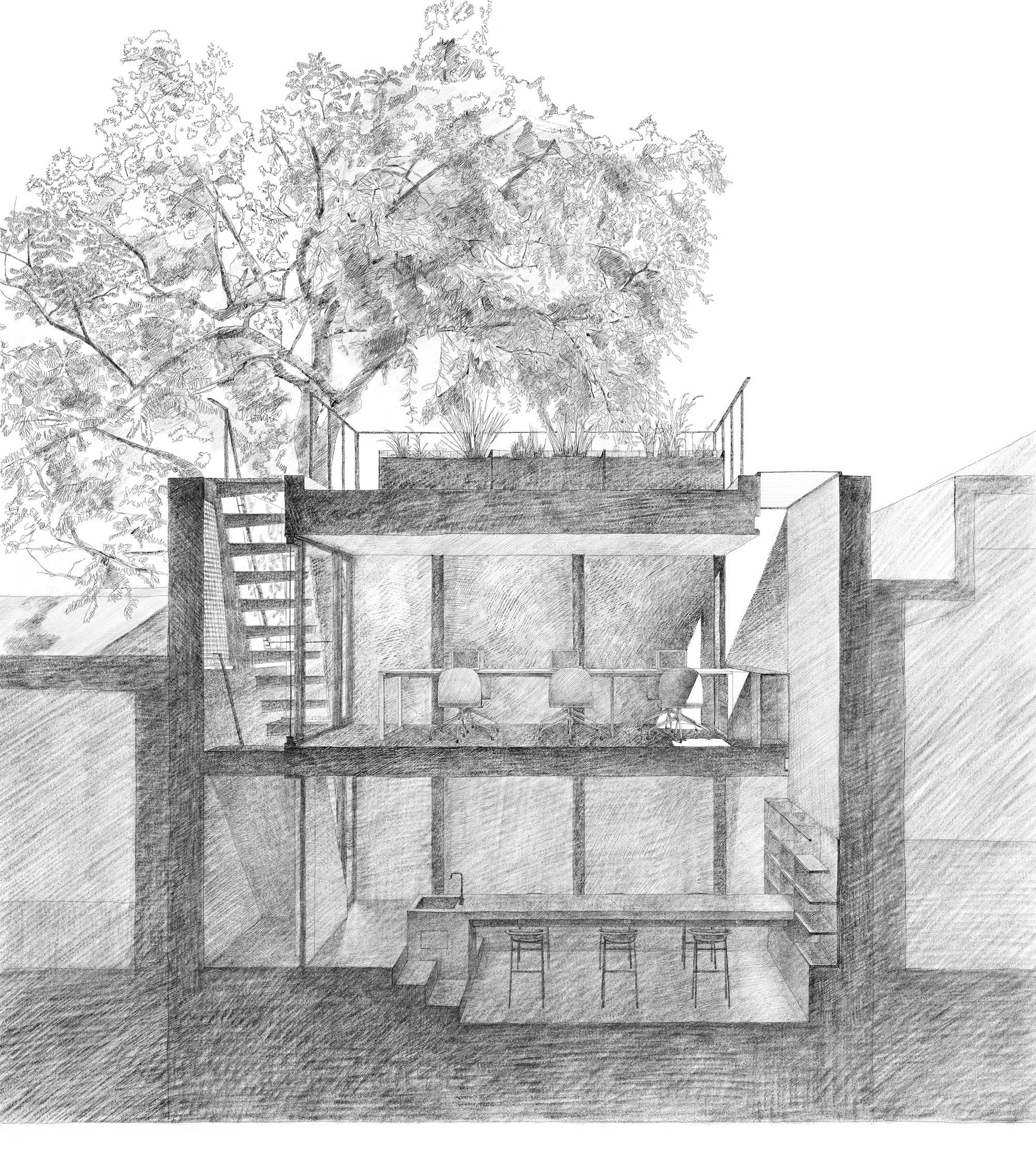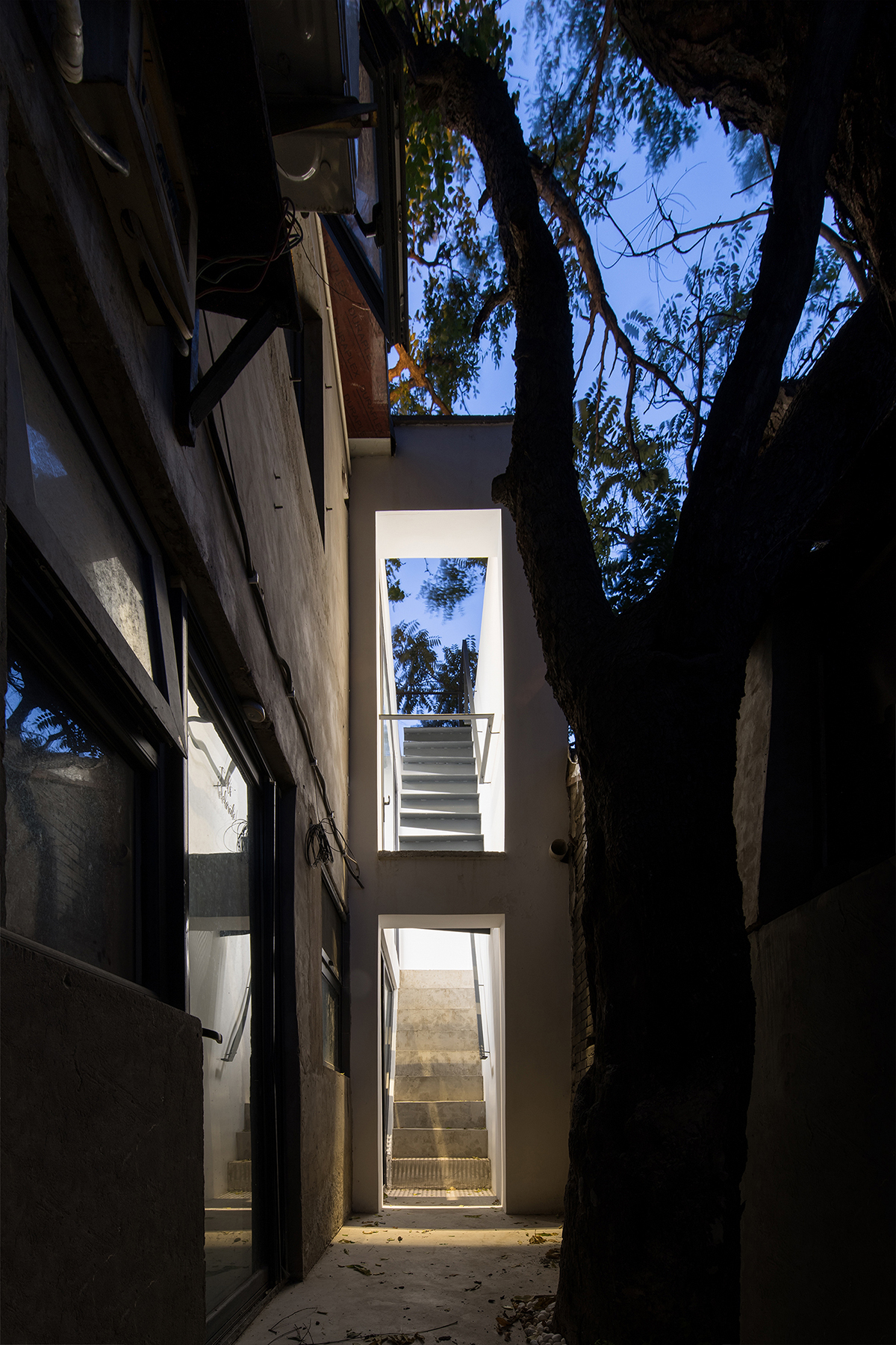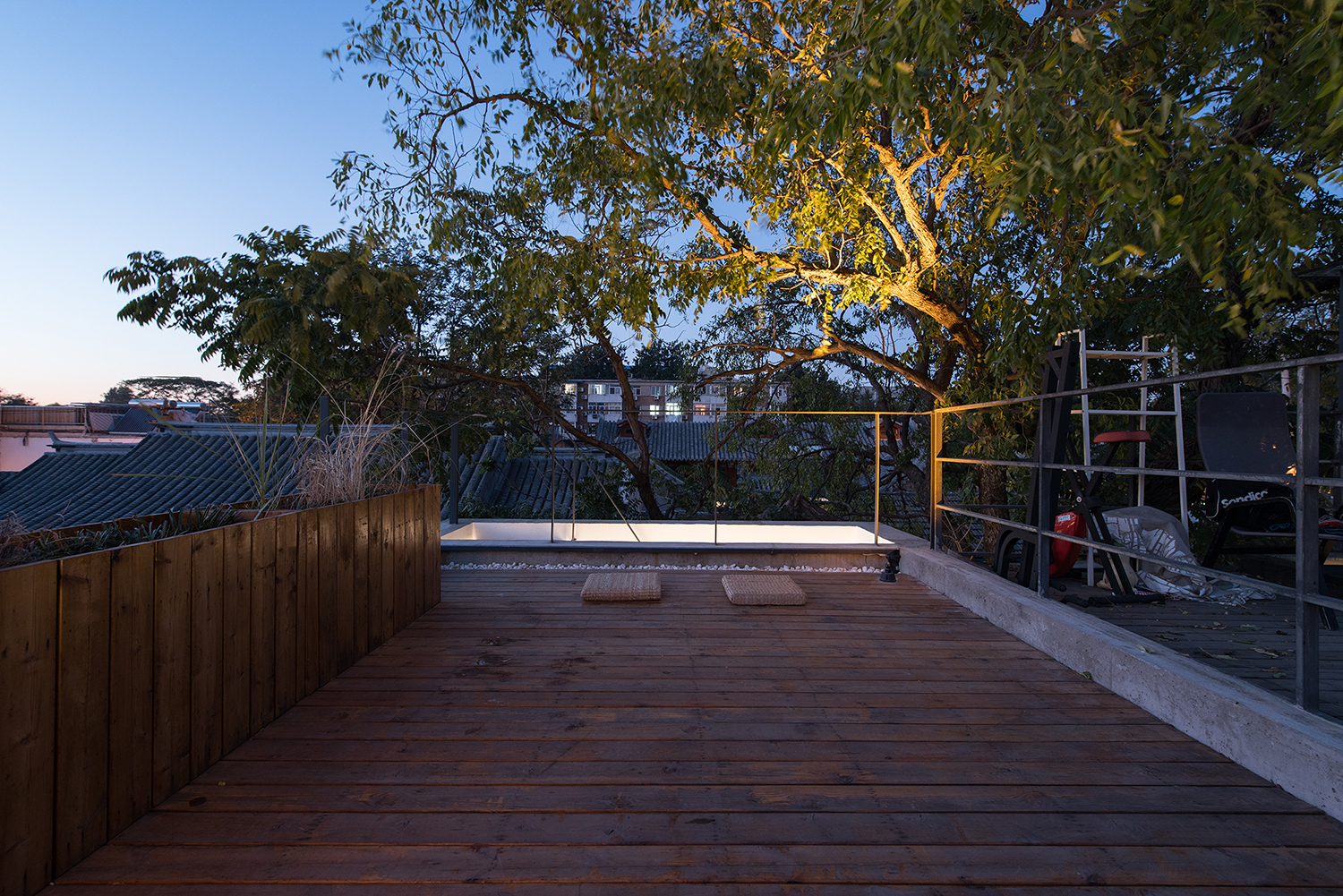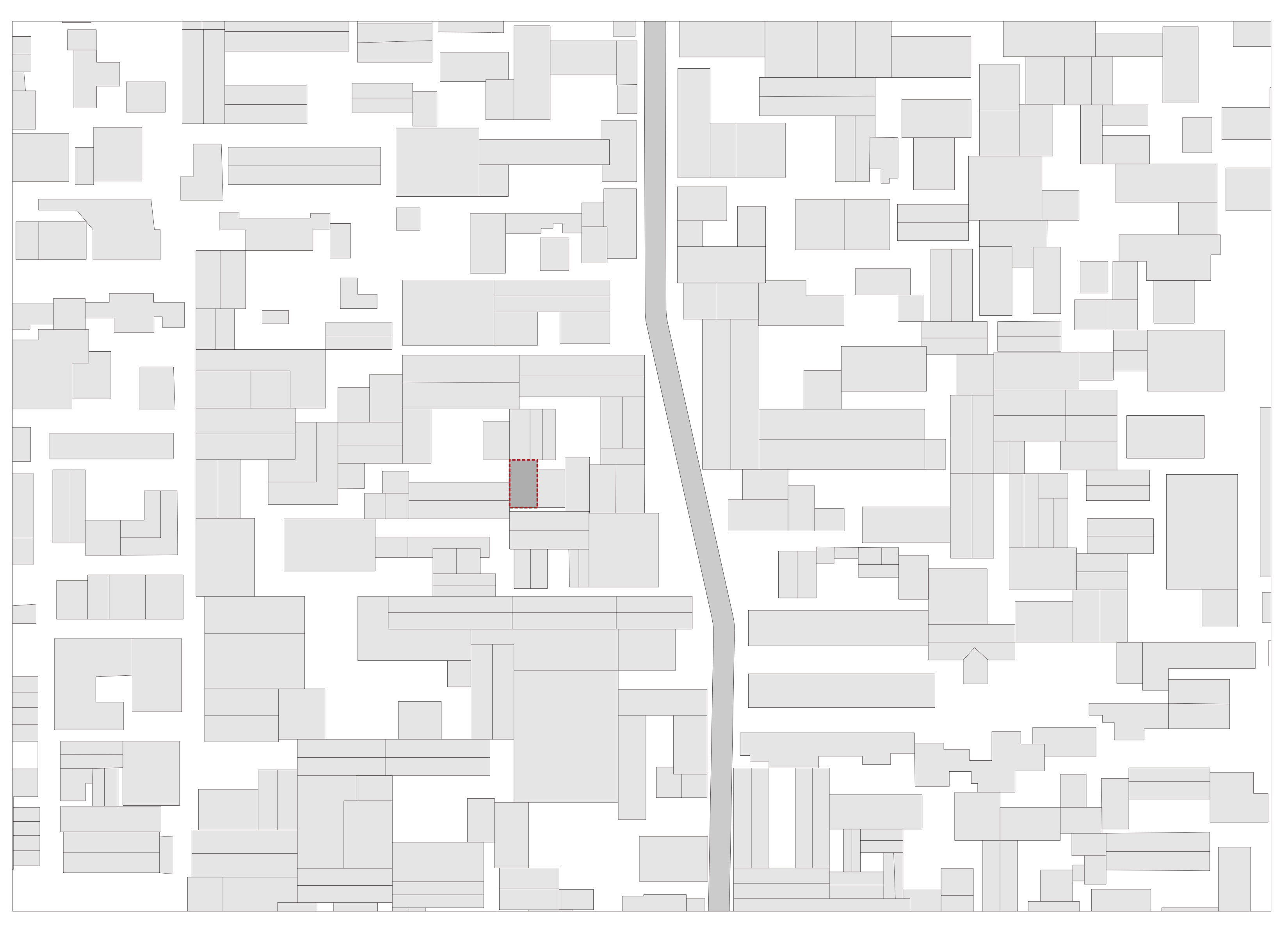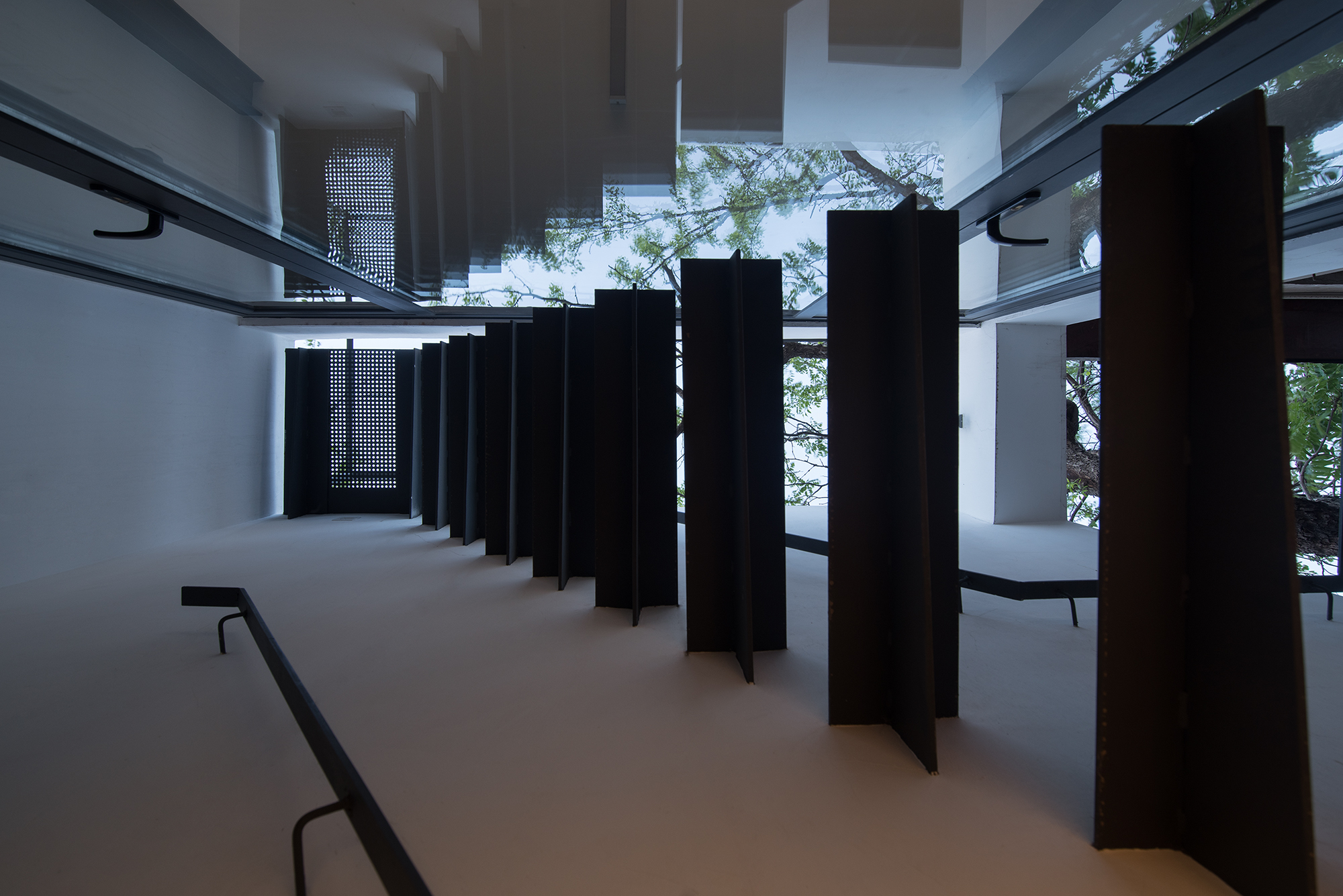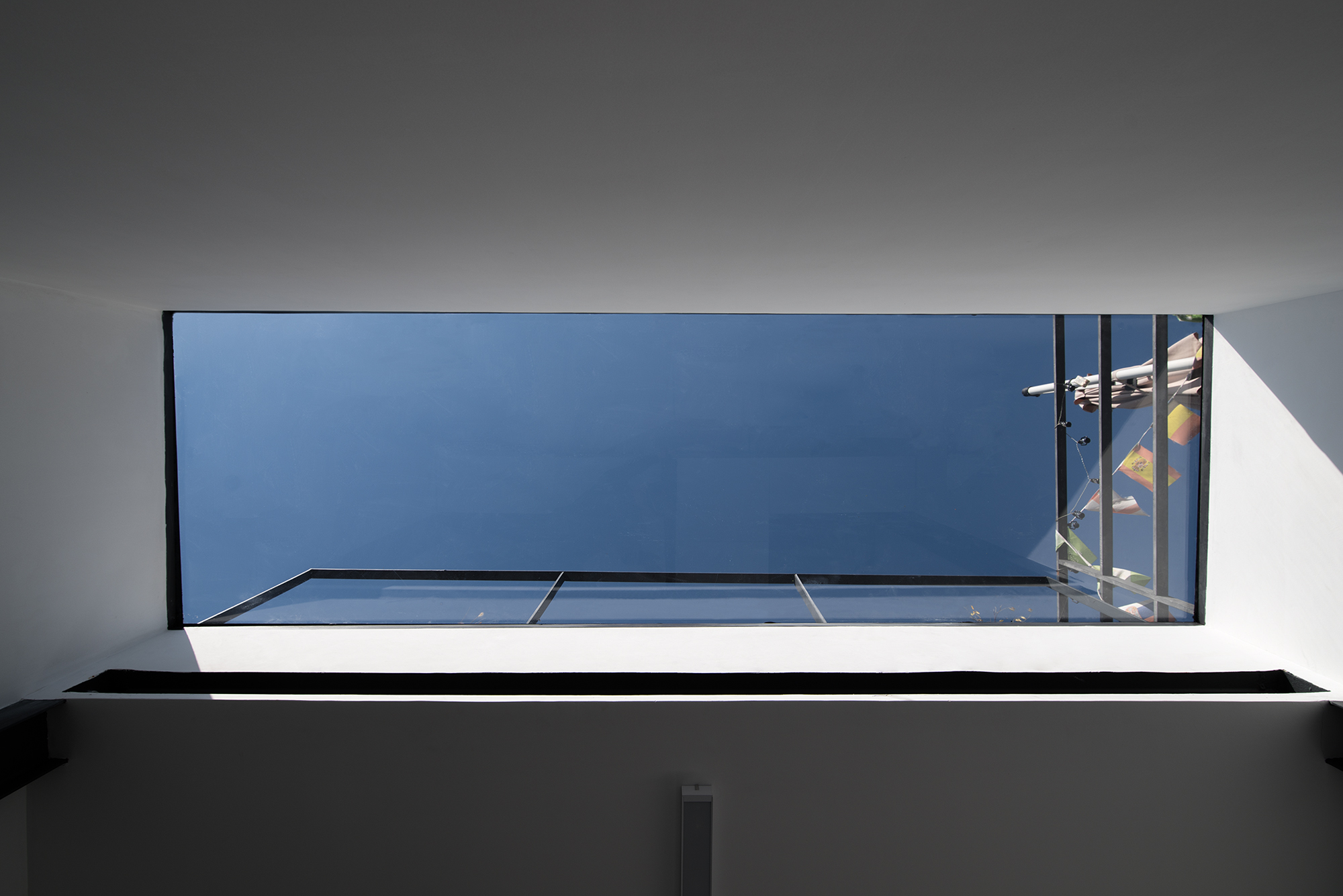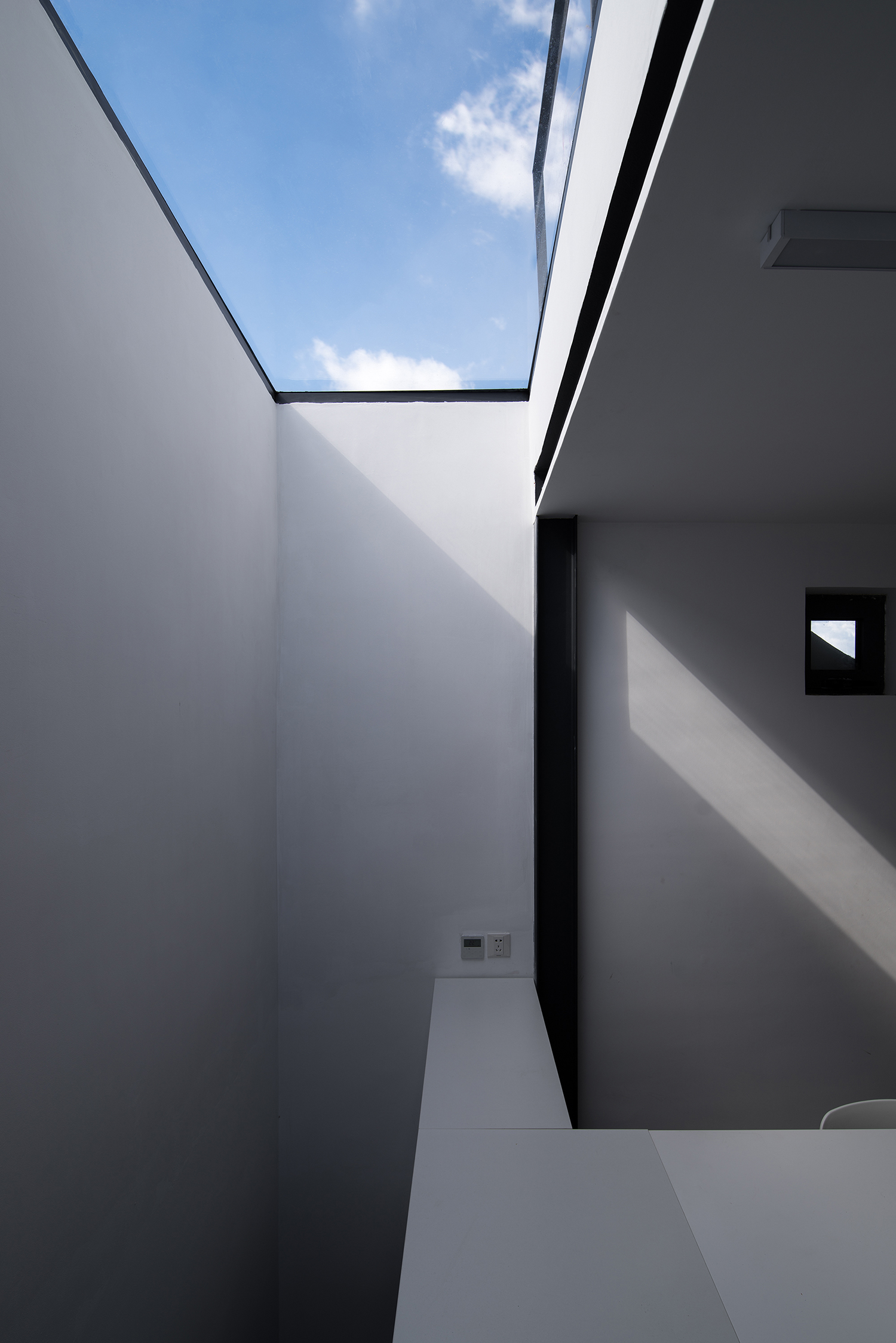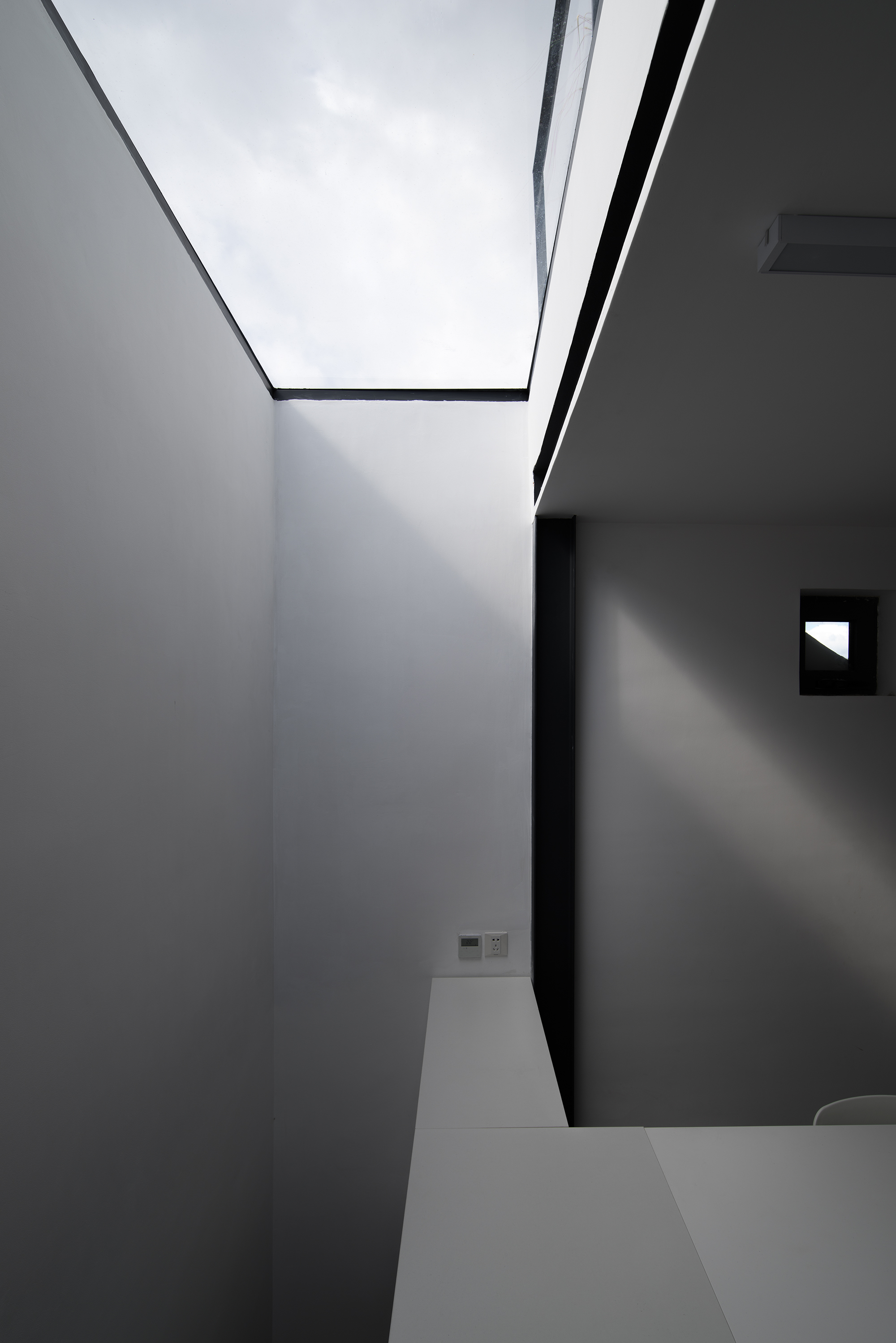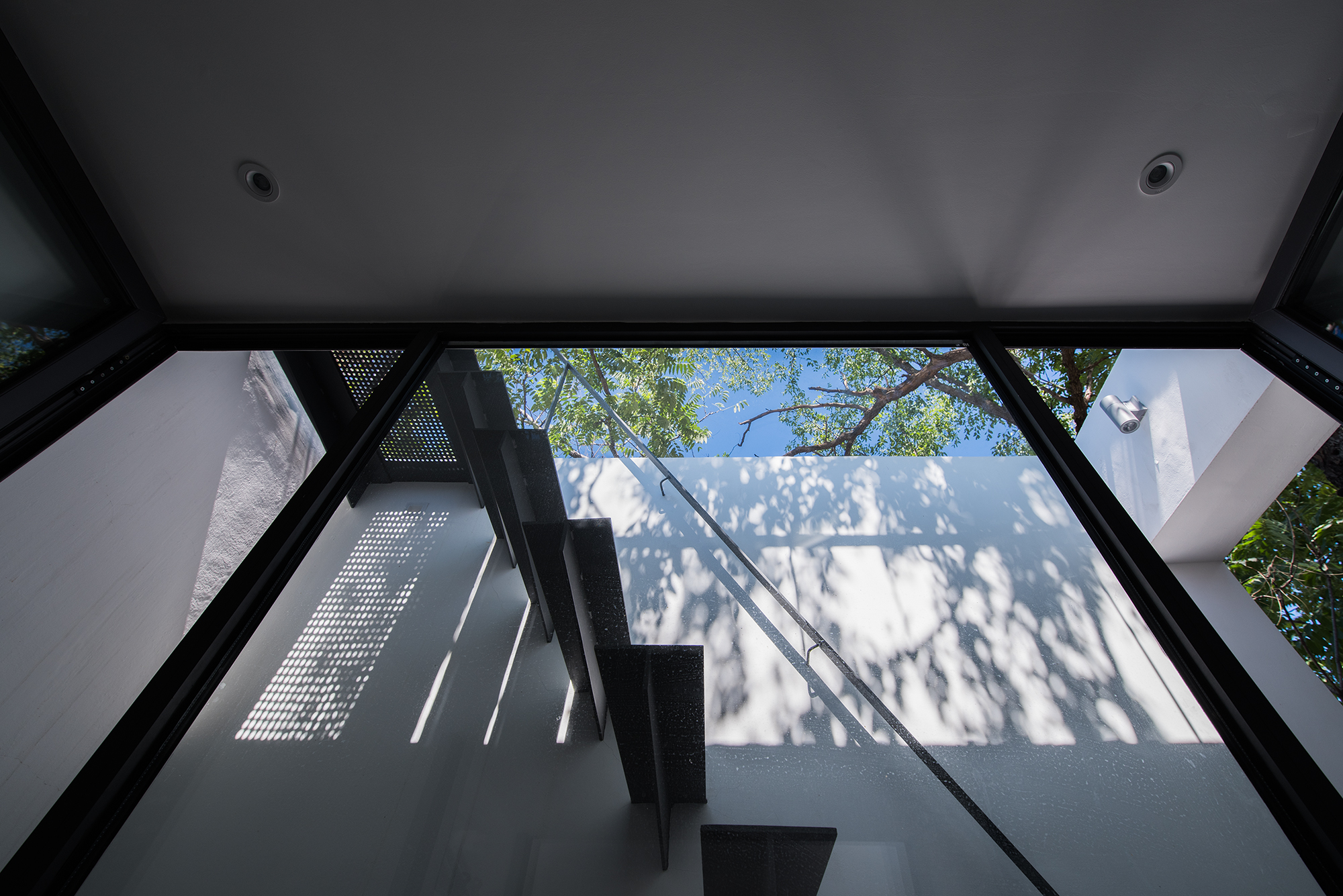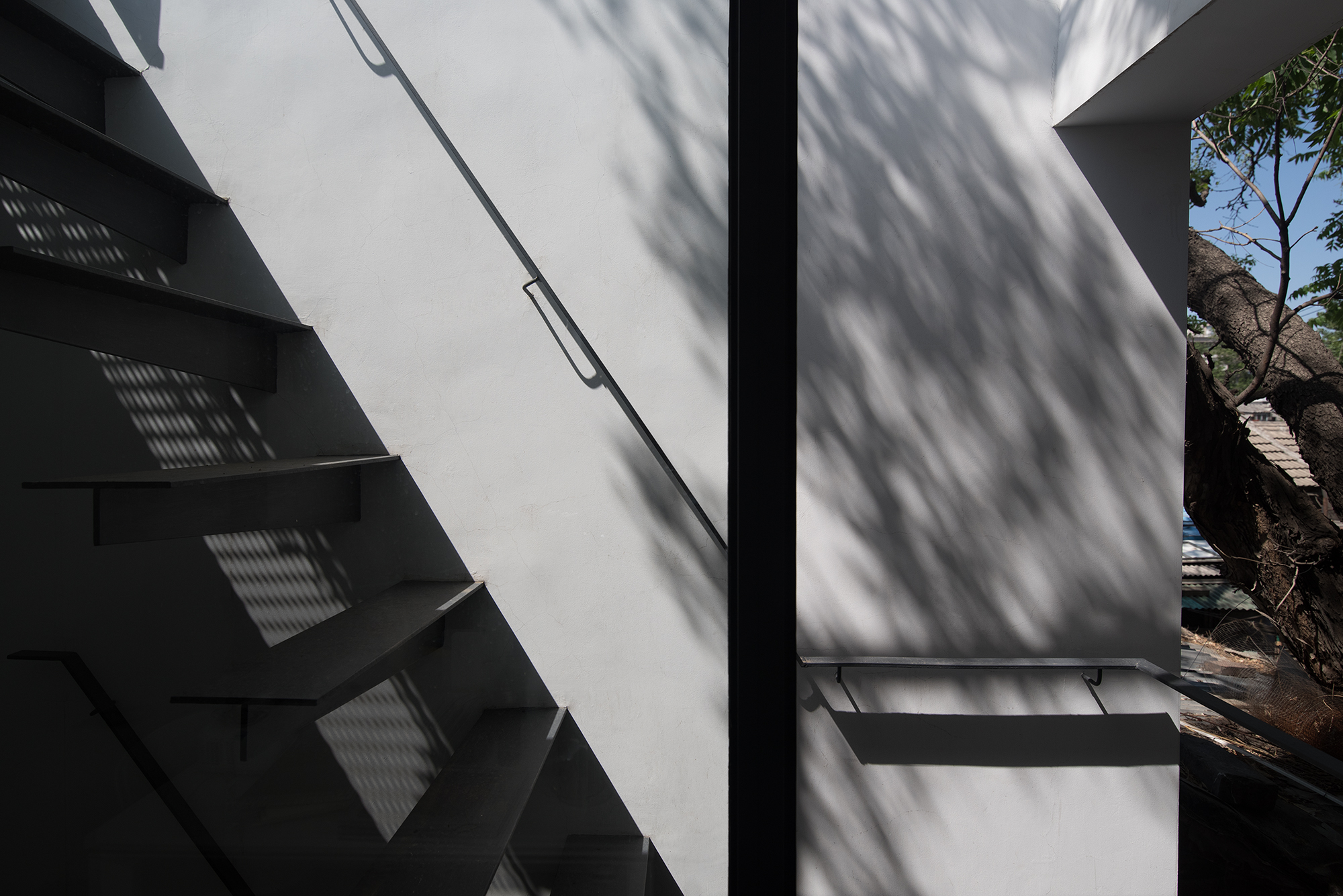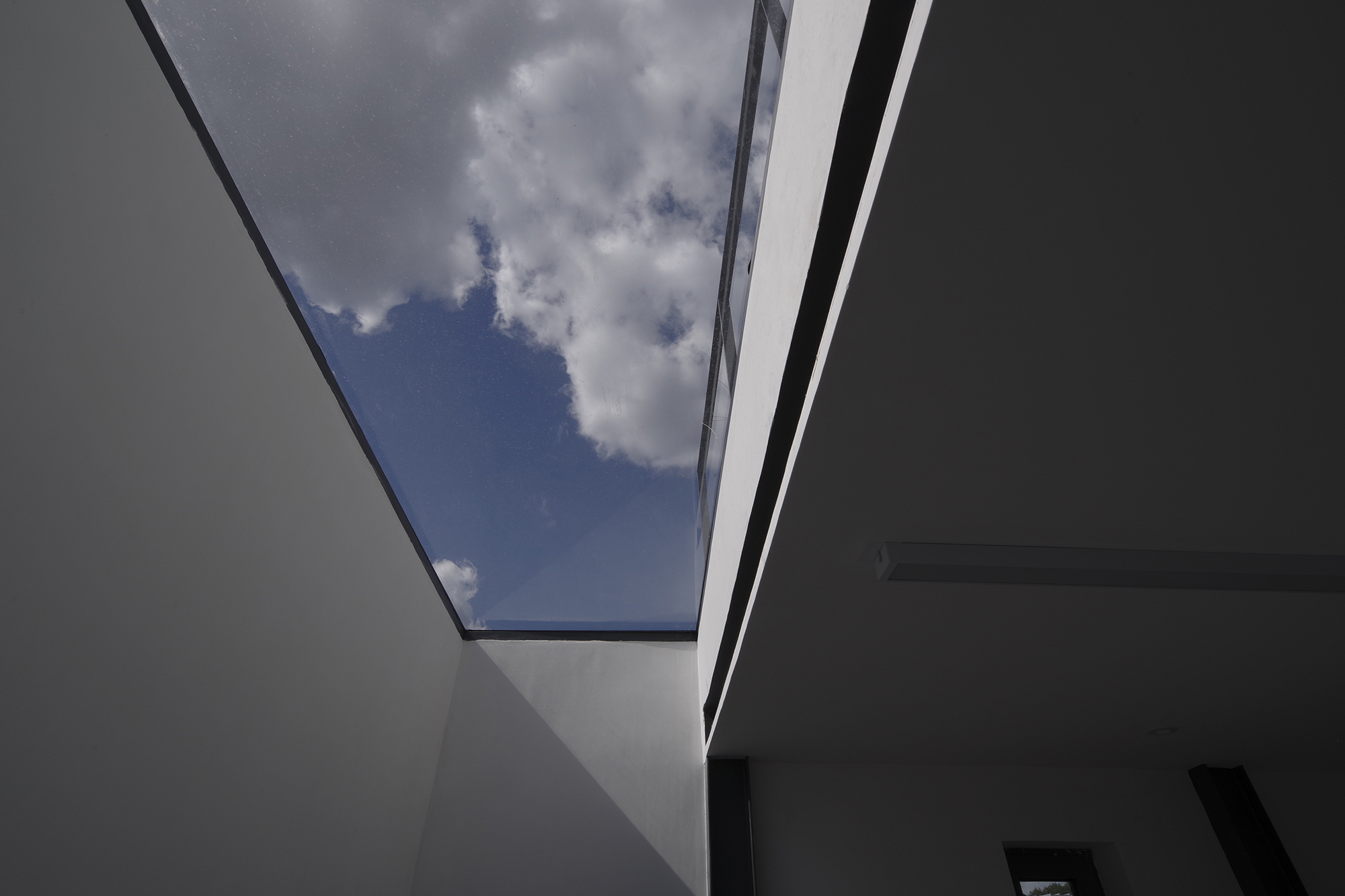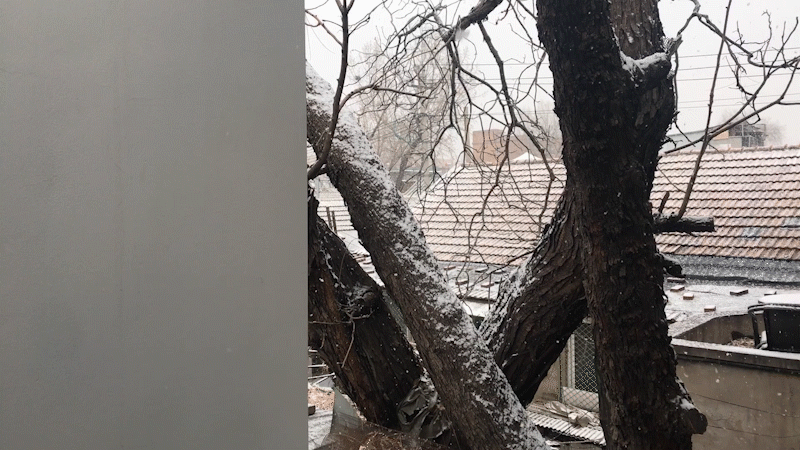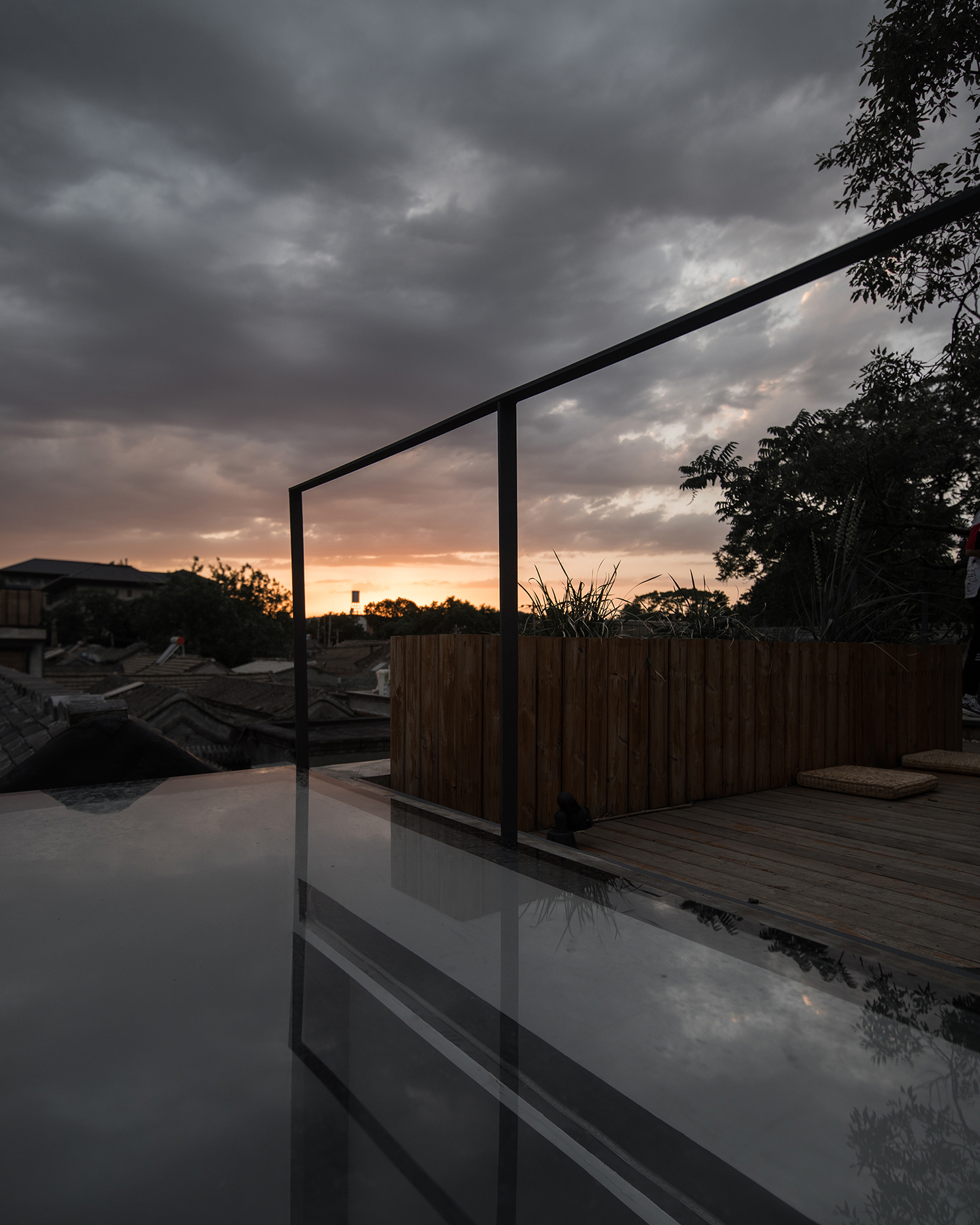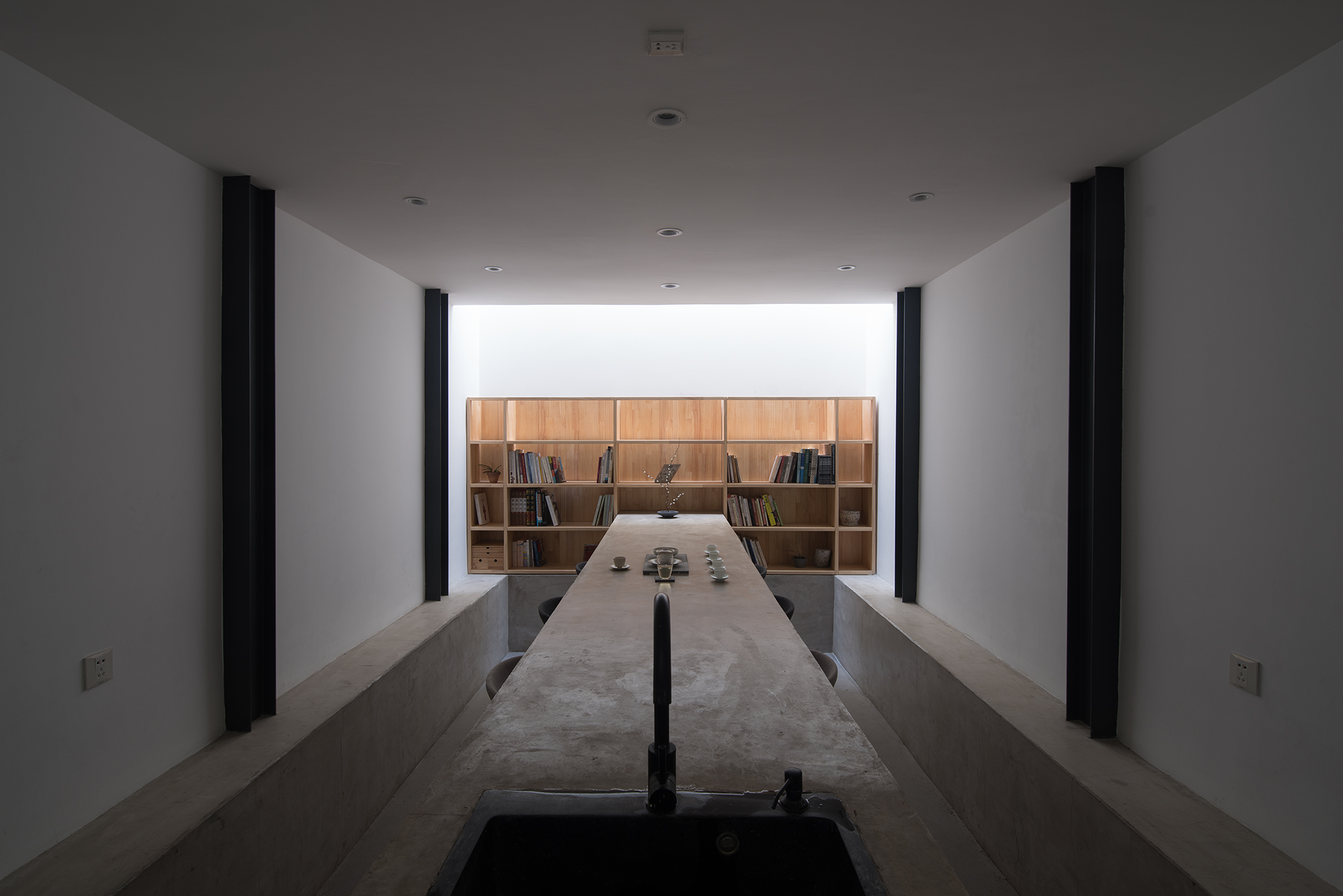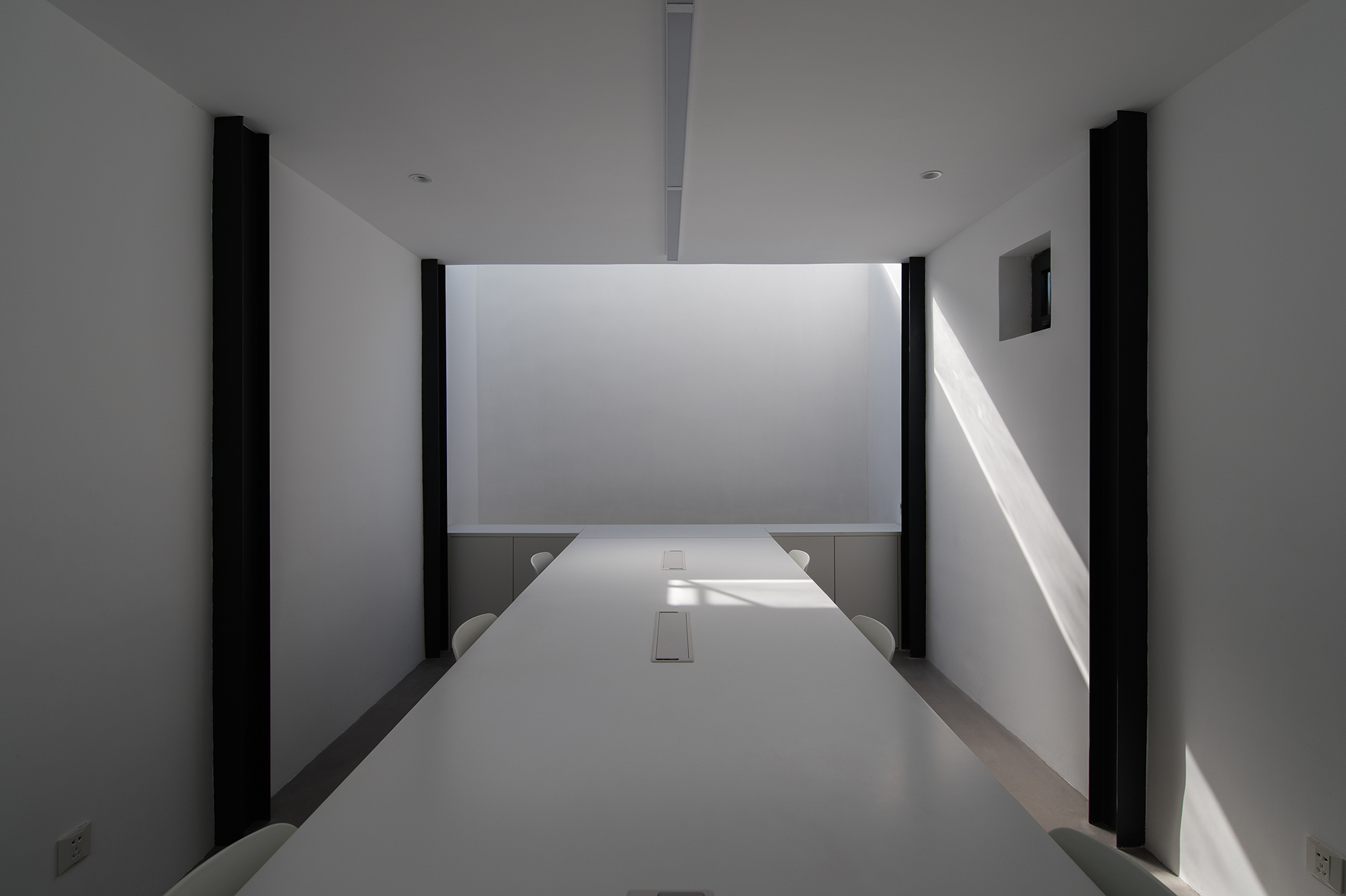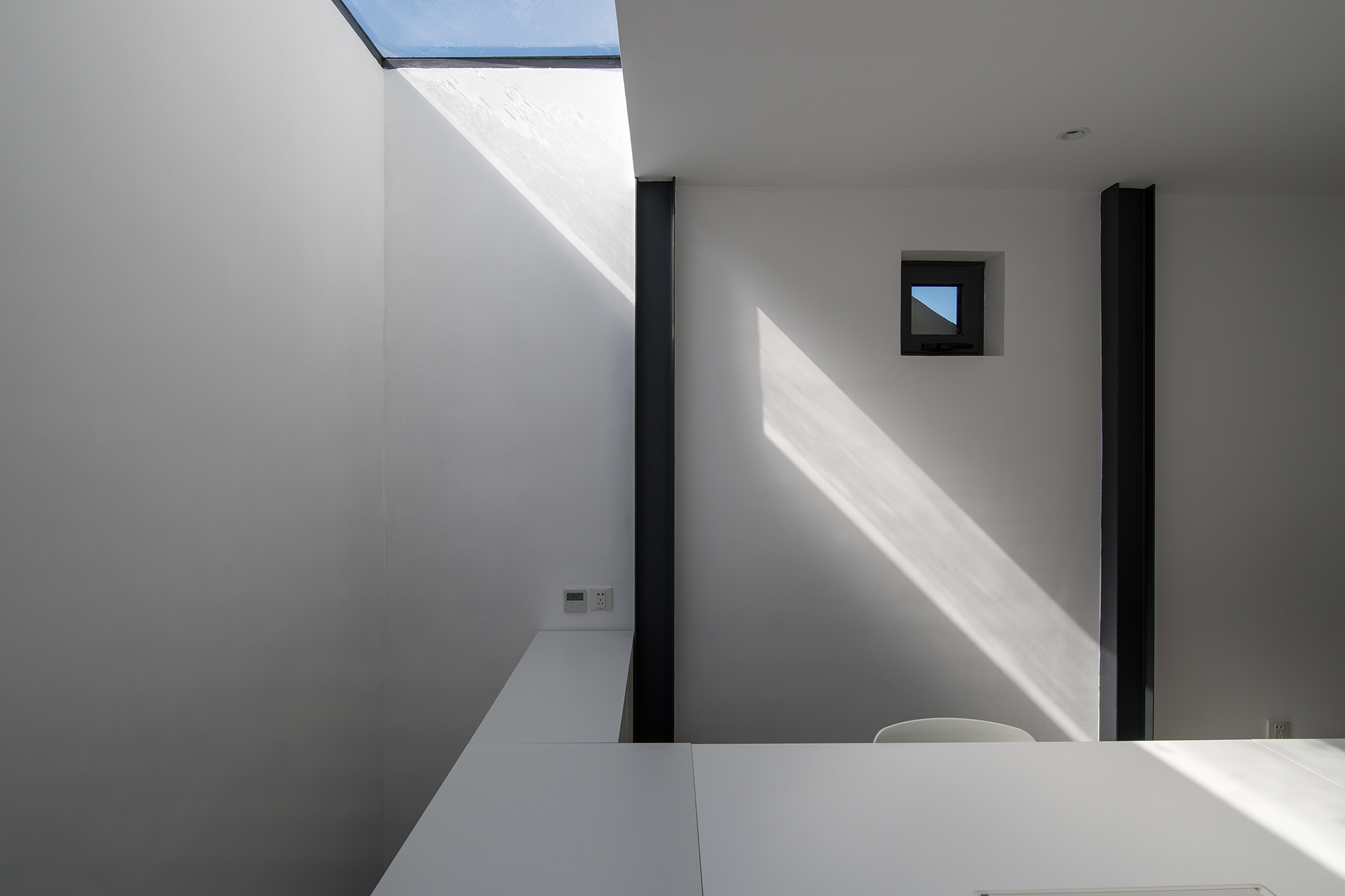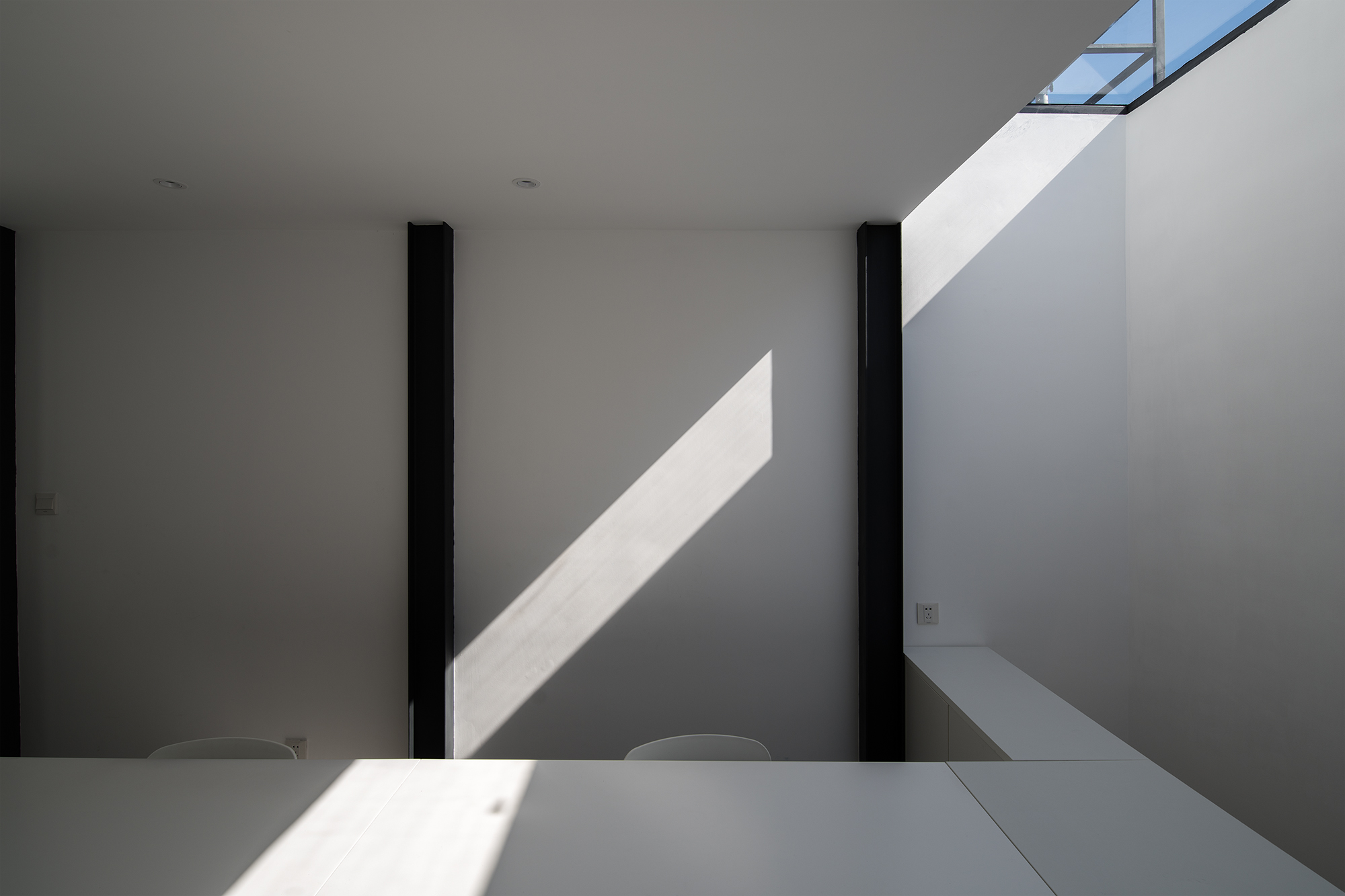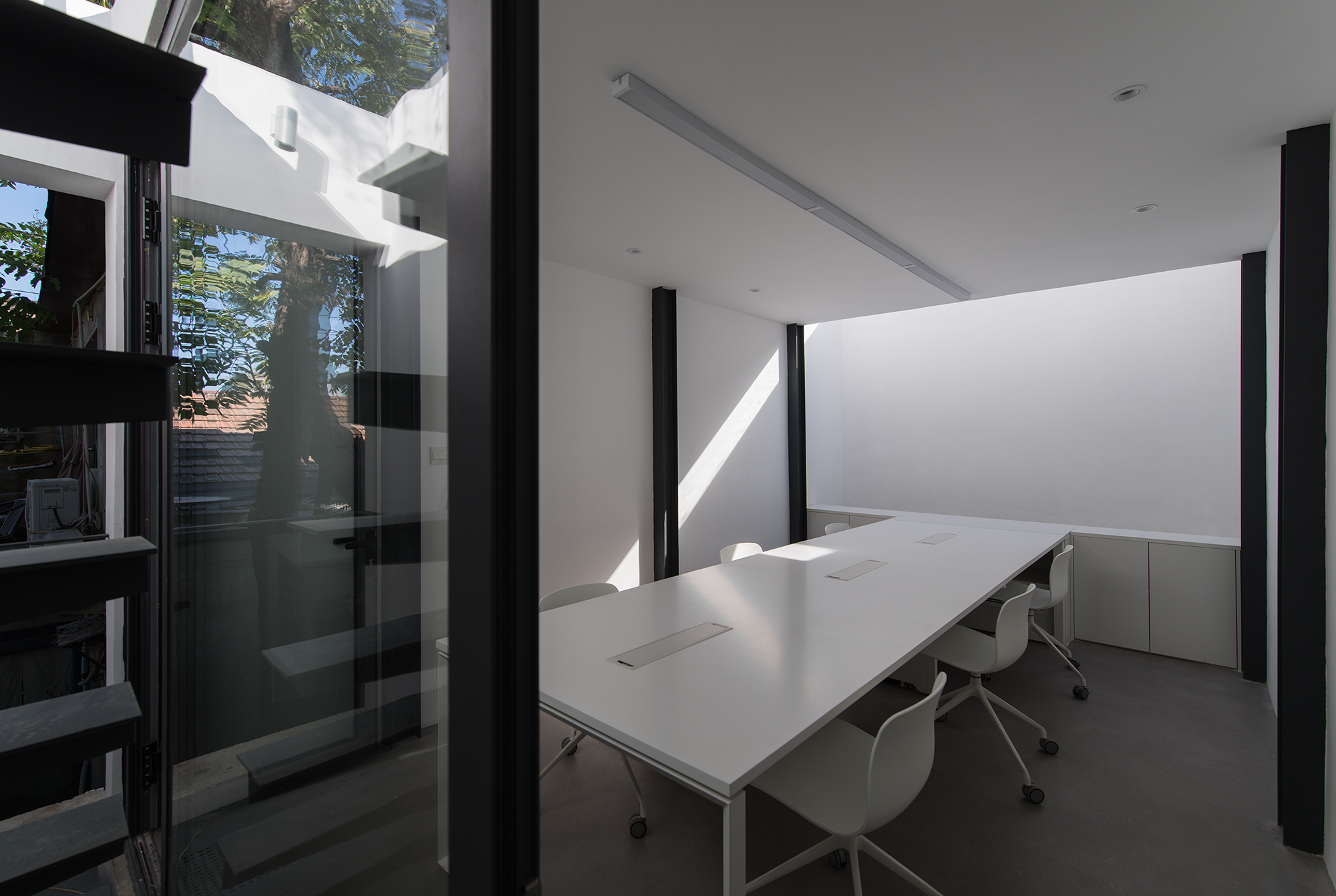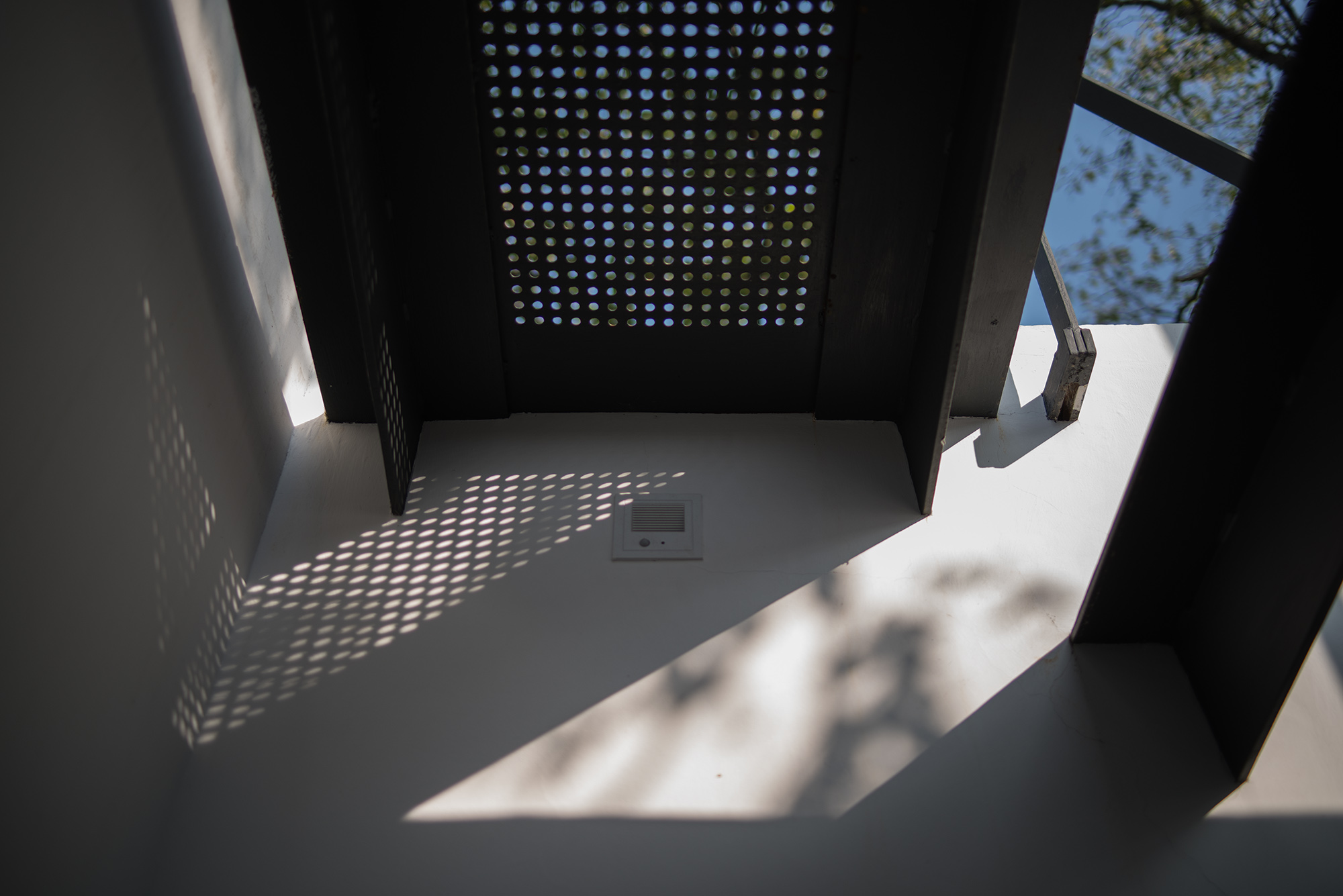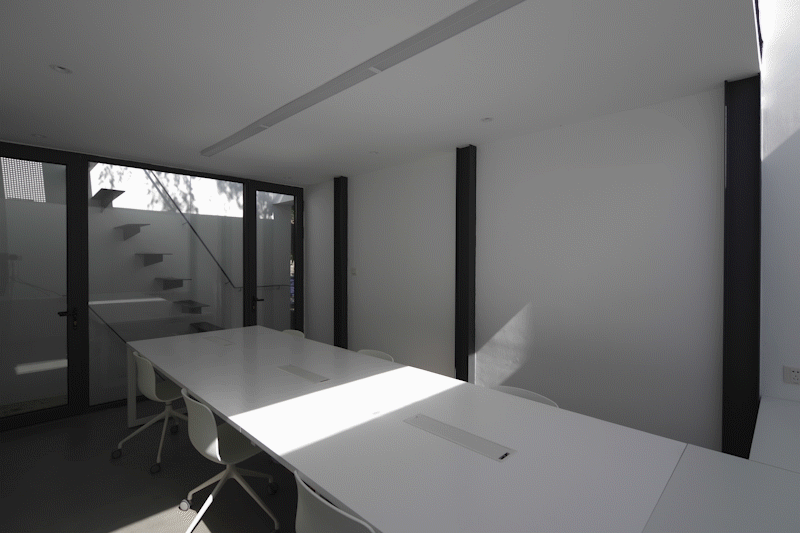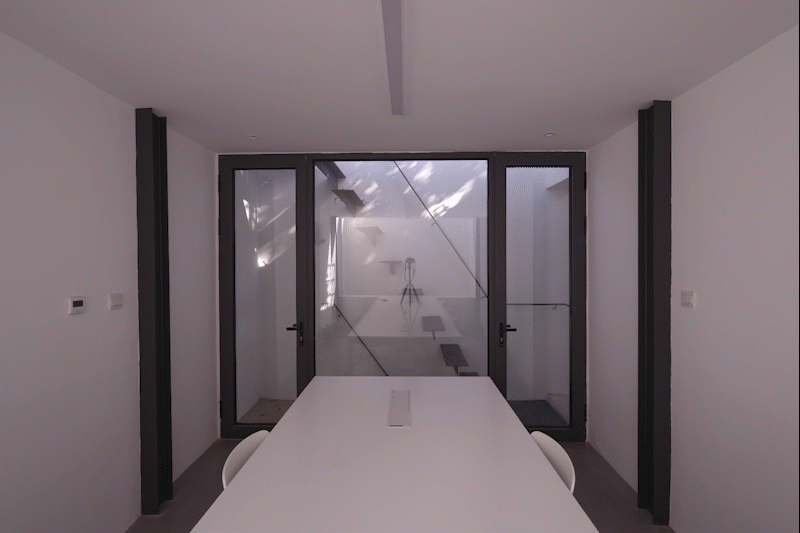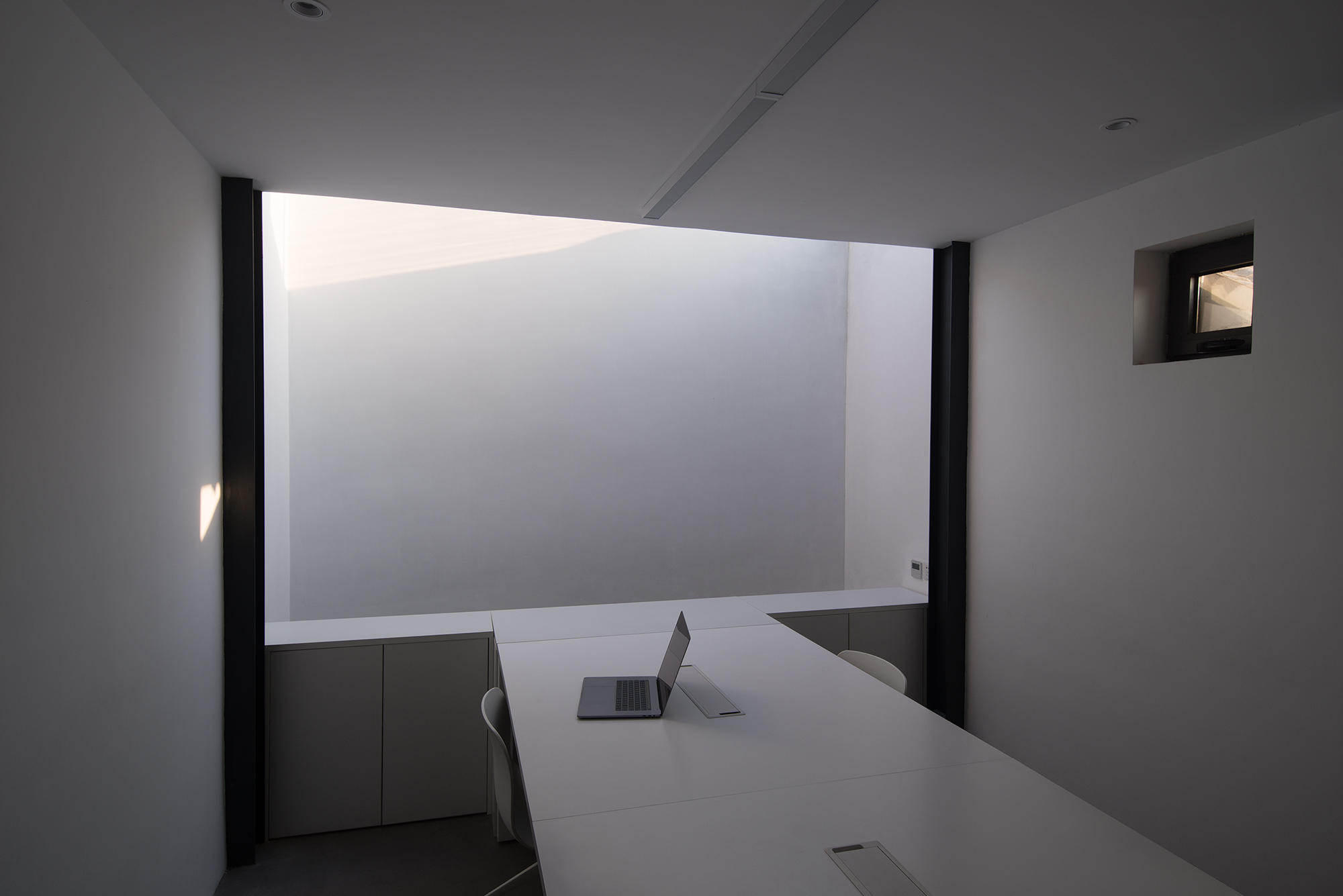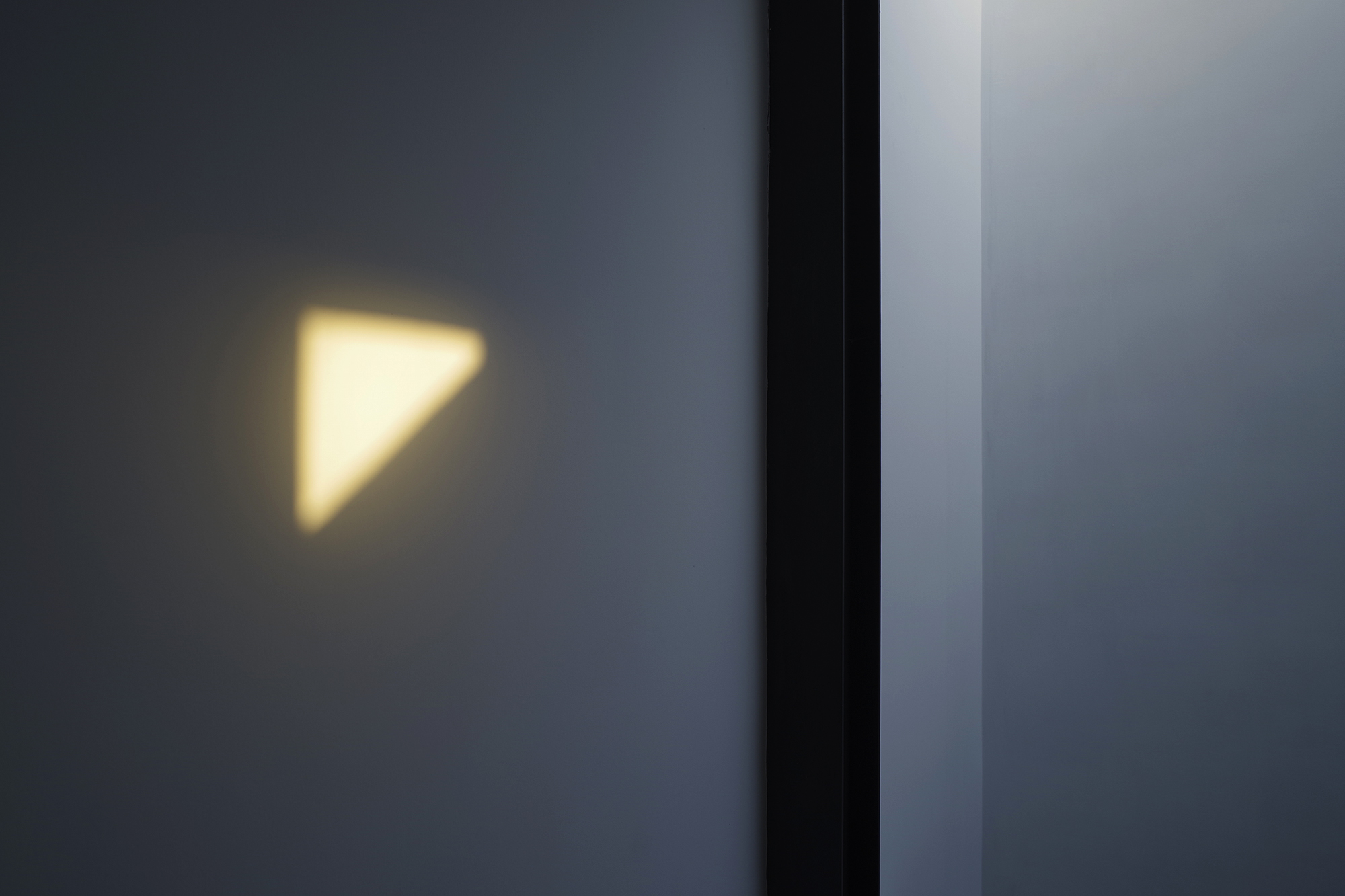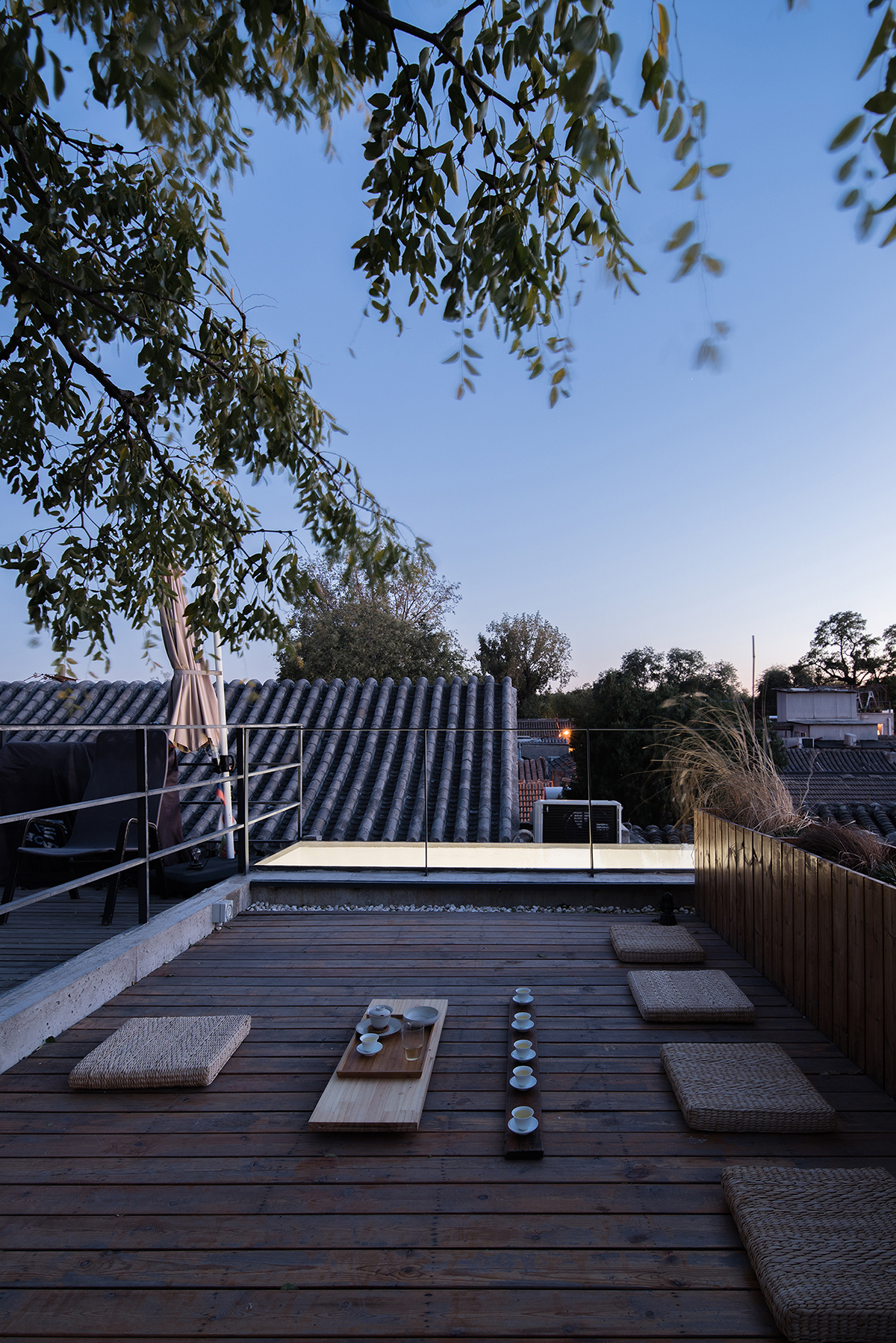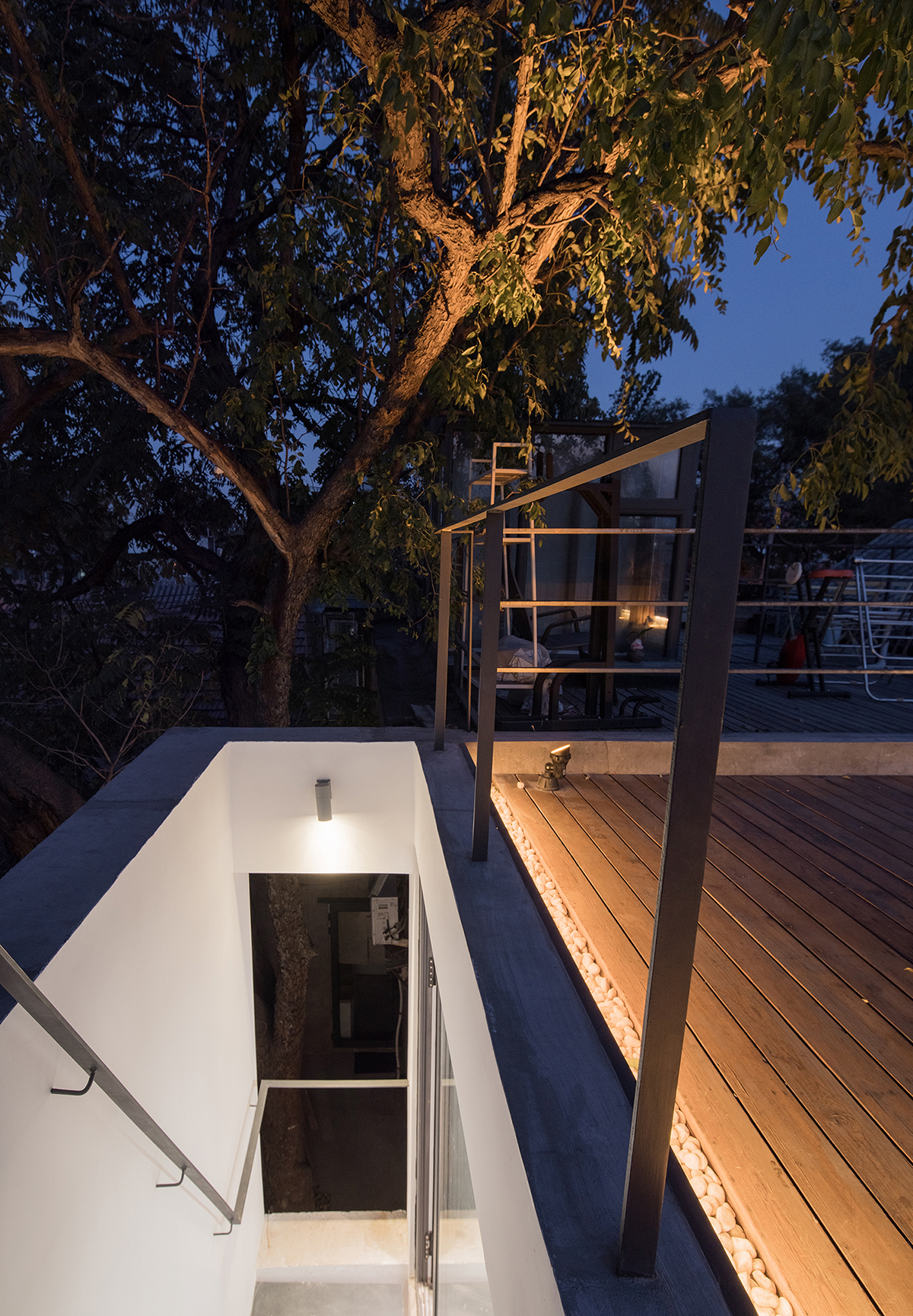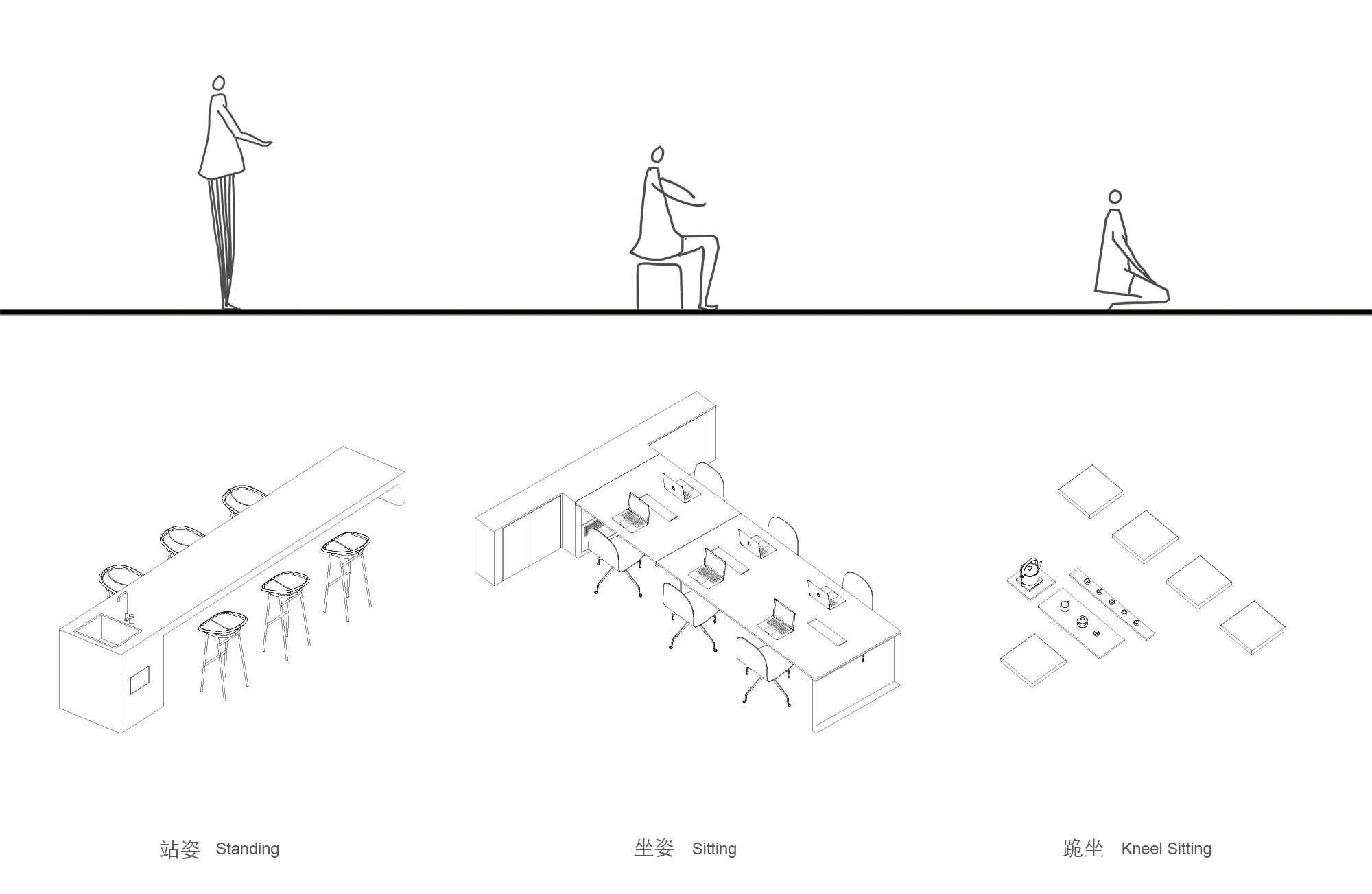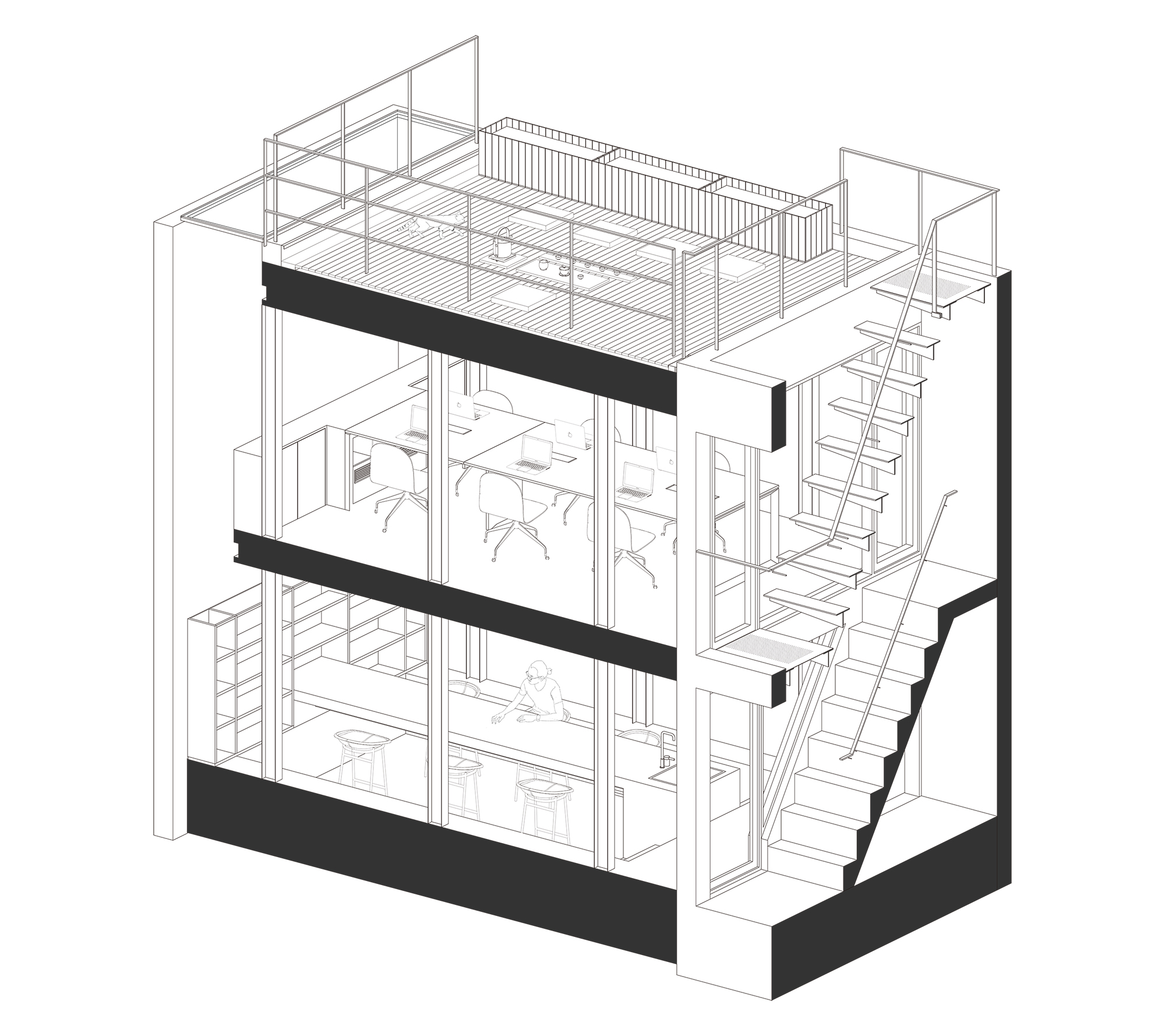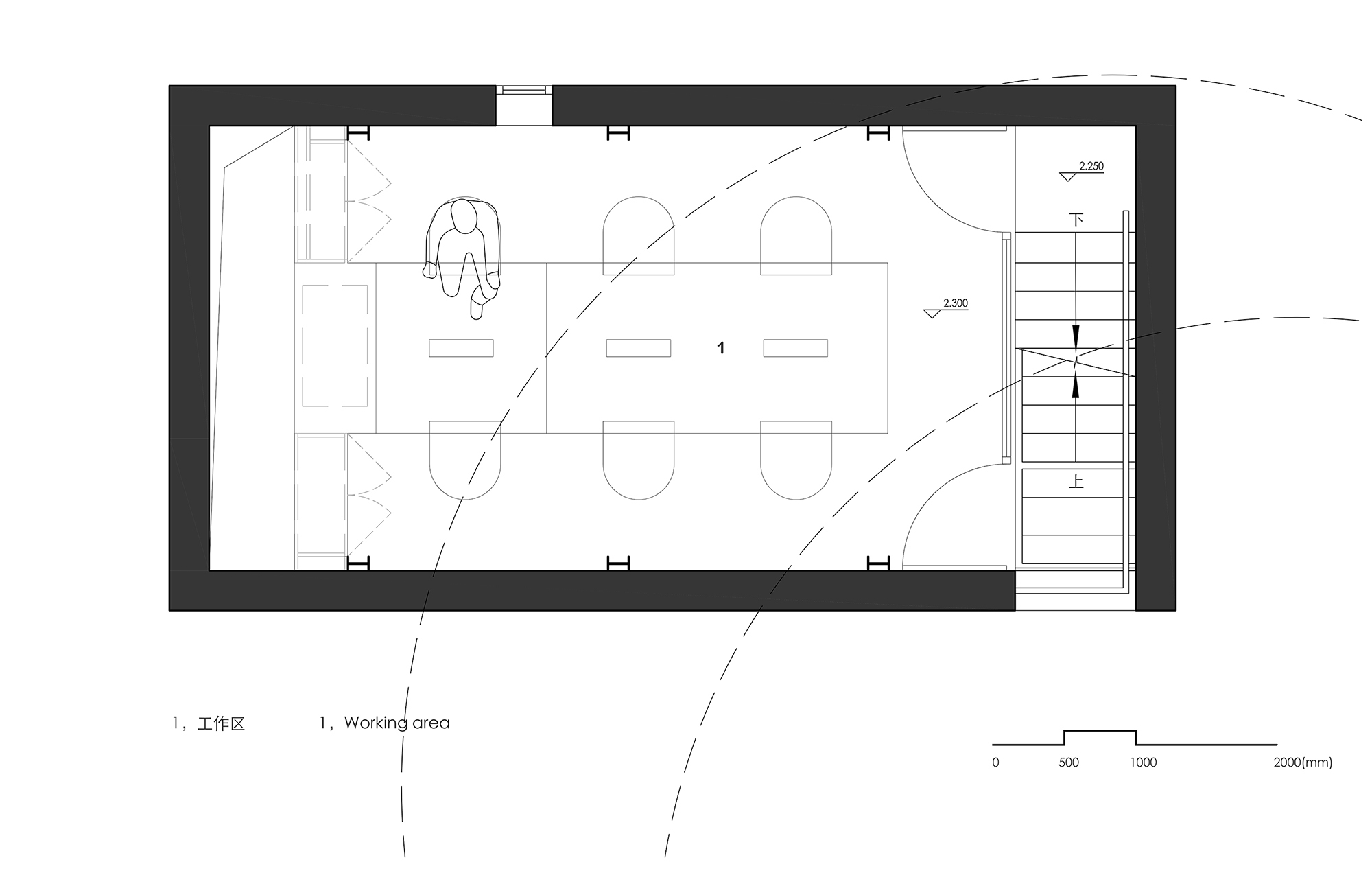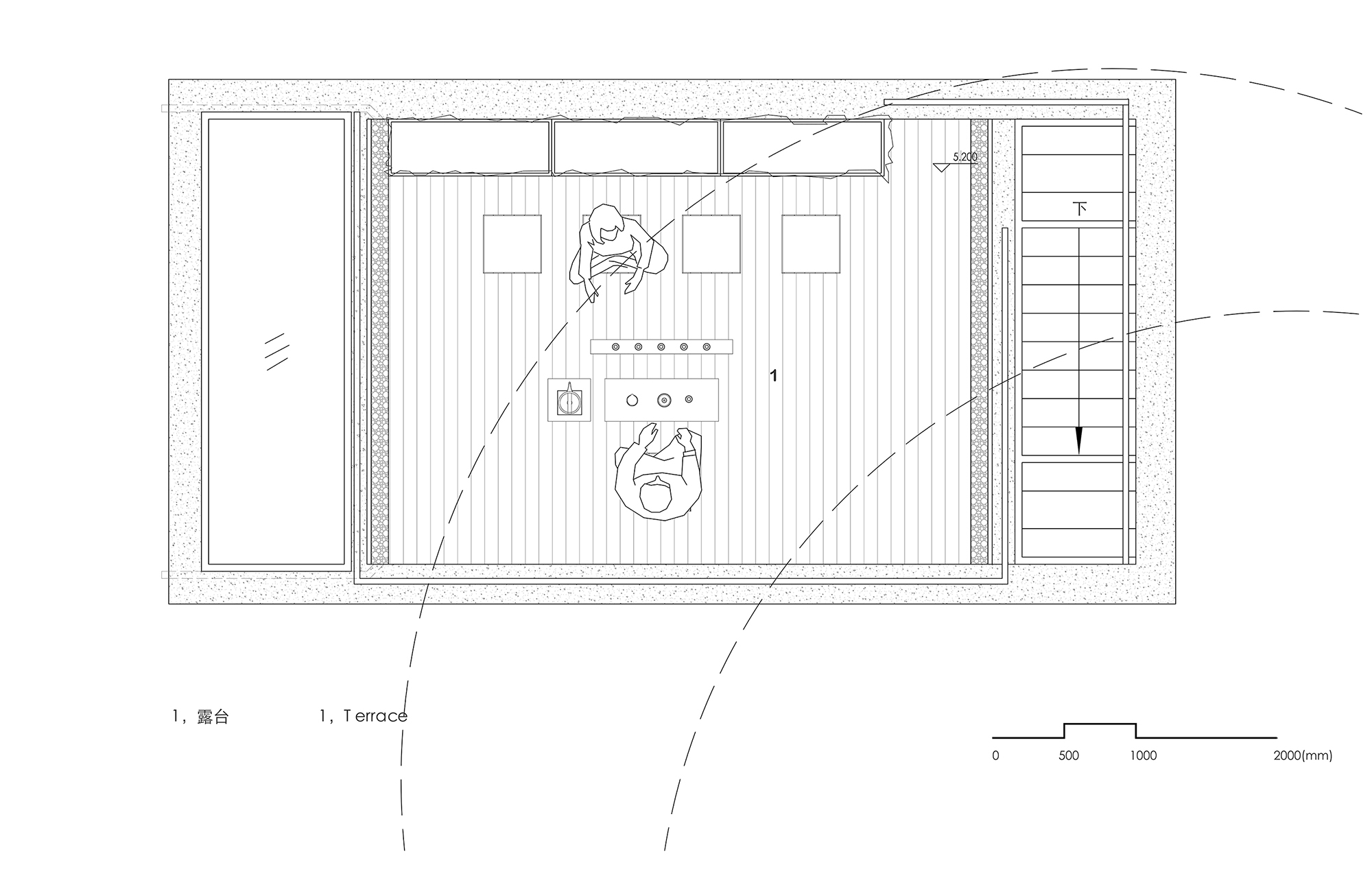场地位于北京市小经厂胡同的一个大杂院内,地处西南角。占地仅为26.1㎡,四周皆与邻居相接,其采光、通风与私密性是一个极大的问题。第一次来到这里,我就被入口处的枣树和香椿所吸引,场地与树的关系暗示了在这里建筑的可能。我们想要在这里营造一个融入自然的工作室。
Site is located at the south-west corner of a mixed-used courtyard in Xiaojingchang Hutong in Beijing. The site is only 26.1㎡. Lighting, ventilation and privacy are major problems on the site. First time the architect has been here, he was drawn to the jujube and the toon tree at the entrance. The relationship between the site and the tree suggests the potential of a building here. The architect decides to construct a studio integrated into nature.
▲入口草图Sketch for the entrance
▲树影墙草图Sketch for the wall catching the
▲剖透视图Perspective section
▲入口 Entrance
▲枣树 Jujube Tree
▲总图 Site Plan
空间的探索首先从四合院出发。由于场地的限制,建筑四周被封闭起来,外墙封闭下,空间通过设置内院开放向自然,这是四合院空间形态的同构。但是由于空间过于狭小,内院进一步缩小为天井,这种带有狭小天井的封闭空间是中国传统民居中常见的类型。外围的封闭获得私密性,向内的开放获取自然。
Exploration of space begins with the prototype of “Siheyuan”, four-sided enclosed courtyard. With the site constrained, the building is enclosed on four-sides. Within the perimeter walls, inner space opens up to nature through a courtyard. Under the constraint of space, the central courtyard is compressed into patio on one side. This kind of enclosed courtyard with a narrow patio is a typical spatial typology in Chinese vernacular architecture, where the enclosed perimeter wall provides privacy and opens inward to nature.
▲生成图解, Generation diagram
在占地26.1㎡的狭小空间中,划出3.6㎡作为天井。天井下设置楼梯,同时也放下一个储藏室。天井的出现扭转了建筑本身的不足。结合室内增设一处吹拔,南侧设置天窗,封闭的空间获得了充足的采光。
The architects divides 3.6㎡ out of 26.1㎡ as patio. The staircase is placed under the patio as well as a storage room. The patio dramatically transforms the quality of the space and improves the lighting and ventilation of the building. Along with the double-height space and skylight on the south side, ample lighting is brought into the once enclosed space.
▲悬挑台阶Stairs cantilevered from the building
▲仰视天窗Looking up to the skylight
在这个极小的空间里,想要创造丰富的自然并不容易。我们通过“借景”的方式将自然引入建筑,建构一个充盈的内部世界。在这里建筑与自然的关系不仅是视觉上的呼应,更是丰富的身体体验。
Within the extremely limited space, constructing a spatial experience with various depth of nature is rather challenging. Through “view borrowing”, the architect brings nature into the building, creating a rich internal world.
▲晨光When the dawn breaks
▲晴天Sunny day
▲阴天Cloudy day
▲树影Shadow of the tree
▲树阴Shadow of the tree
▲云景View of Cloud
▲雪景View of Snow
▲晚霞 At dusk
建筑由两层加一个露台组成。一层局部下挖,以增加层高,作为多功能室使用。可喝茶,聊天,开会,移动办公,聚餐。光线从两侧的天窗和天井中撒落下来,让空间在一天当中充满变化。中间用混凝土浇筑的吧台桌集成电源,充电接口,洗手盆等,方便各种功能的使用。书架取消顶板,将第二层隔板镂空,以便光线从书架上透射下来。
The building consists of two floors and a roof deck. Part of the first floor is dug down in order to increase floor height for multi-purpose uses: tea drinking , socializing, conferencing, mobile working and dining. Quality of the space throughout the day changes as the light fells from the skylight and patio among different times. The cast-concrete counter integrates charging station and sink, equipped for all-purpose use. The top of the shelf is removed and the second tray is carved out for light to shine through.
▲吧台与书架Counter and book shelves
▲书架轴测图Axonometric drawing of the book shelves
二层光线极佳用作日常办公使用,一组矮柜设置在吹拔边缘既作为栏杆,又是中央空调室内机的外罩,矮柜衔接长桌,形成一体,简化空间中的物件。来客不知空调所藏何处,又能感受到温度的舒适性。二楼的台阶使用8厚钢板,从墙上生根长出,使其显得轻盈,让光线可以更多的进入下层空间。
The second floor is perfect for daily office use with ample lighting. A set of low cabinets is set on the edge of the double-height space, as the railing and the cover for the internal unit of the central air-conditioning. The cabinet is attached to the long table as one. The air conditioning is hidden from the visitors. One can simply enjoy the comfort of the perfect room temperature with the minimalistic interior. The stairs to the second floor using 8mm steel plates cantilever from the wall appearing aloft also allowing light to enter the lower level.
▲光线透过天窗进入二层空间Light enters the second floor from the skylight
▲天窗自然光Natural light from the skylight
▲楼梯间看向办公区Looking at the office from the staircase
▲树下的楼梯间The stairs under the tree
▲台阶细部The detail of the stairs
北面墙体内侧是整个建筑最丰富的部分。阳光透过枣树枝叶,拍打在白色墙面上,犹如水墨画一般,在微风下晕染开来。随着时间和天气的变化而变;由于太阳高度角的变化,画面也会随季节而高低起伏。这里产生了一幅365天都在变化的画。
The northern wall is the most expressive section of the building. Light shines through the jujube leaves, and the shadow hits on the surface the white wall , as if a Chinese ink painting spreads on the canvas with the summer breeze. Following the angle of the sun rises and falls in different times and days of the year, there creates an ever-changing painting.
▲室内光线变化Light changes in the interior
▲天井一天的光线变化Light changes in the patio
西面墙体留出一扇小窗,正对邻居家山墙斜线,既暗示与相邻建筑的关系,呼应空间中台阶的斜线,同时也为夕阳的射入提供了一个通道,让黄昏时的仪式感照进办公室,提示着白天的结束。
The western wall of the building leaves a small window facing the elegant curve of the slanted roof of the neighboring building that creates the relationship in between as well as resonates with the oblique angle of the stairs. The small window also opens a tunnel for the sunset shines in, which brings a sense of ritual into dusk, at the end of a day.
▲西窗与夕阳West window and sunset
▲夕阳投进办公区Sunset in the office
露台进一步探讨与枣树的关系,设计中使用蒲团及矮茶台,让人更贴近地面,被枣树包裹在其下面,营造树下静坐的适宜尺度。西侧以木质花池为栏杆,提高私密性,傍晚时分,坐东朝西,透过花池上的植物,欣赏西边落日。
The roof deck furthers the conversation between the building and the jujube tree. The de-sign of the cushion and low tea table are intended to lower the body wrapped around by the jujube tree, that renders a space under the tree for meditation. On the west side, wood-en planters are placed as railings to ensure privacy. At the dusk, people sit facing west, through the silhouette of the flowers in the planter, and enjoy the sunset.
▲露台茶席The Tea Table on the deck
▲楼梯间回看枣树Looking from the stairs to the jujube tree
▲鸟瞰图Birdview
在三个不同标高的建筑空间中,我们探讨身体的三种姿态与建筑及家具的关系。一层1100mm高的吧台对应闲适的“站”姿,二层750mm高的桌子是日常工作的“坐”姿,露台100mm的茶台是偏仪式性的“跪”姿。我们希望在这个极小的空间中回归对身体充分的关照,以人体及人的活动为尺度,营造与之相适的场所,这也是我们所追求的“自然”。
In the architecture space with three different floor heights, the architect discusses three dif-ferent postures of human body and modules between furniture and architecture. On the first floor, the counter of 1100mm corresponding to “standing”. On the second floor, the 750mm-desk replies to the need for the daily “sitting” position. On the roof deck, the 100mm tea table suggests a ceremonial posture, “kneeing”. With these attempts in minimal living and working space, the architect hopes to recall the attention to human body and construct the place for it. It is the “nature” that we believe in.
▲家具分析图 Analytical drawing of the furniture
▲剖轴测图 Axonometric Section
▲一层平面图 First Floor Plan
▲二层平面图 Second Floor Plan
▲屋顶平面图 Roof Deck Plan
项目信息——
项目名称:樹院
设计:兼建筑
公司网站:www.a-jian.com
项目设计:2018.04-2018.08
项目完成:2018.08
主创设计师:陈培新
团队:陈培新,常哲
项目地址:中国,北京
建筑面积:41.8㎡
摄影:陈培新
客户:兼建筑,向量建筑
Project information——
Project name: Tree Courtyard
Designed: Atelier Jian
Website: www.a-jian.com
Design year: April 2018-August 2018
Completion Year:August 2018
Leader designer: Chen Peixin
Team: Chen Peixin Chang Zhe
Project location: Beijing, China
Gross Built Area :41.8㎡
Photo credits: Chen Peixin
Client: Atelier Jian,XYZ Studio



